Practices of Urban Inclusion: Towards a Learning & Teaching Network
Viviana d’Auria, Layla Zibar, Sebastián Oviedo and the DESINC LIVE project network

Viviana d’Auria, Layla Zibar, Sebastián Oviedo and the DESINC LIVE project network
This report was produced by KU Leuven with input from all the institutions that are part of the project: DESINC LIVE.
Authors: Viviana d’Auria with Layla Zibar and Sebastián Oviedo
Contributors: Markus Bader, Giorgio Baracco, Lucia Caistor-Arendar, Ida Castelnuovo, Beatrice De Carli, Vera Fritsche, Tahmineh Hooshyar Emami, Rowan Mackay, Stefano Pontiggia, Katharina Rohde, Angelica Villa.
Design: Sebastián Oviedo
Published by: KU Leuven (2022)





ISBN: 9789464447262
Suggested citation: Viviana d’Auria, Layla Zibar & Sebastián Oviedo, Practices of Urban Inclusion: Towards a Learning and Teaching Network (Leuven: KU Leuven, 2022).
For further information visit: www.desinclive.eu
DESINC LIVE – Designing and Learning in the Context of Migration is a project funded by European Commission under the Erasmus+ programme (2019-2022).
Project partners: Architecture Sans Frontières–UK, KU Leuven, London Metropolitan University (2020-2022), Politecnico di Milano, Refugees Welcome Italia, Schlesische 27, Universität der Künste Berlin, University of Sheffield (2019-2020).

This report describes the design and key findings of an evaluation process that concerned a EU-funded strategic partnership titled: DESINC LIVE – Designing and Learning in the Context of Migration (desinclive.eu). Since October 2020, the experimental educational offer that was collaboratively designed by a group of fourteen educators, researchers and practitioners from four Higher Education Institutions (HEIs) and three Civil Society Organisations (CSOs) based in four European countries was evaluated from muliple perspectives. The assesment was designed in line with the ambition to gauge the educational offer’s coherence vis-à-vis the core values around inclusion it aimed to endorse and the ensuing ambition to replicate a refined version of the course collaboratively designed from September 2019 onwards.
DESINC LIVE’s focus on the interface between questions of migration and urban inclusion on the one hand and the field of urban planning, architecture and spatial practice on the other, is rooted in a first strategic partnership carried out in 2015-18 called DESINC –Designing Inclusion (desinc.org). This first experience and its outputs, which can be consulted here, set the grounds to orient subsequent efforts towards the co-design of a pilot educational offer. The latter could unfold on the basis of lessons learnt from a review of spatial design education experiences tackling migration, an analysis of CSO-led practices of urban inclusion, in addition to a playbook and an online course targeting educators interested in engaging with migration issues in and beyond Europe.
Two reports, which can be found here, summarise the first two phases of the process concerning the course that was co-designed as a pilot, co-taught as a team, and, finally, co-assessed during and after its implementation by a diverse group of evaluators including learners, teachers and internal/ external contributors mobilised in varied aggregations. The course was conceived from inception, meaning in pre-Covid times, as a blended educational offer that would strategically rely on online teaching and learning. Nonetheless, the breakout of the pandemic and its unfolding throughout the project and across the European continent and beyond, challenged the team to consider aspects of inclusion, access and mobility in relation to the course and its core topics well beyond what had been originally prospected.
Questioning the limits and spaces of what teaching and learning can mean for more just cities, and where teaching and learning actually can take place, was a prime premise for the partnership as a whole. Several partners explicitly advocate for the rights of refugees - and migrants more generally - to be not only acknowledged, but viewed as the starting point to renew perspectives and reshape values in fundamental ways. Evaluating how this came about in multidimensional ways, and what obstacles and opportunities have arisen during the implementation process, is therefore more than fulfilling the conventional duty of course assesment. Rather, critical reflection and evaluation have been seen not only as a post-implementation assessment, but especially as a method accompanying teaching and learning activities in meaningful ways. This perspective, which usually brings about more questions than answers, and more points of improvement than celebratory takeaways, if taken on board with thoroughness and consequence, has the potential of enacting change at various scales, levels and dimensions.
Practices of urban inclusion: Towards a Learning & Teaching Network
This report includes five parts:
Part I introduces the context, structure and basic aims of the report
Part II presents the results of the different evaluation phases for each course component
Part III is centred on the options and opportunities for the course’s replicability in the future
Part IV synthesises the major findings from previous sections
The Appendices include supporting documentation mobilised during the evaluation
DESINC LIVE – Designing and Learning in the Context of Migration, explores the role that urban space and spatial practice play in creating conditions of exclusion or inclusion in cities. The project is set within the European context and centres on migration as a key component of urbanisation, and an important lens for understanding how dynamics of power, oppression and emancipation relate to citymaking.
The project is particularly concerned with knowledge and learning. What knowledge about cities and migration informs the definition of urban policies and plans? What knowledge underpins the design and material construction of buildings and places? Whose perspectives are taken in consideration in the making of the city, and why? And what can social work and activism gain from a greater understanding of how the built environment works?
The project attempts to address these questions by developing an experimental learning programme that links together professional and experiential knowledge, art practice and urban policy, theory and action. The educational programme aims to provide current and future practitioners with the conceptual and practical tools that will enable them to develop new ways of fostering inclusion in urban space. The basis of the work is a framework of principles, methods and pedagogical tools, developed by the previous DESINC project, that we are now testing ‘live’ with specific learners, partners and sites of engagement.
The project revolves around three main aims:
Designing, testing and formalising an innovative educational offer for students and vocational learners in architecture, urban design, urban planning, urban geography, social policy, social work and other creative and social disciplines concerned with migration and/or urban space and the built environment.
Practices of urban inclusion: Towards a Learning & Teaching Network
Why?
To bring together different perspectives on city-making, while encouraging transdisciplinary thinking, criticality and reflexivity in the teaching of creative, spatial and social disciplines.
Promoting the participation of displaced persons and CSOs in the design and testing of new pedagogical approaches and practices.
Why?
To build a diverse set of narratives about the city, its social changes and the challenge of inclusion, as well as to enhance the capacity of all participants to envision longer-term scenarios for urban transformation, beyond the most immediate needs.
Enabling a further development of skills and competences for higher education teachers and vocational trainers.
Why?
To support educators in renewing their own approaches, methods and tools for tackling complex societal changes in the urban context, as well as to enhance their capacity to contribute to a transversal debate about the inclusive city.
Students in architecture, urban design, urban planning and cognate disciplines who are interested in acquiring new transdisciplinary competences and more awareness of how inclusive urban spaces work and are produced.
Educators in architecture, urban design, urban planning who want to develop new approaches to knowledge and learning in the face of complex societal issues, with a focus on transdisciplinary education and critical thinking skills;
CSOs supporting the inclusion of displaced persons as well as displaced people themselves, who want to develop new knowledge about the urban context, and enhance their capacity to envision and transform urban space.
Practices of urban inclusion: Towards a Learning & Teaching Network
The project is structured around three work packages or Intellectual Outputs.
Methodological and organisational setup of a joint educational programme, including a Digital Learning & Teaching Toolbox.
The setting-up of the educational offer consists in the design of contents, approaches and methods that will inform the partners’ joint learning and teaching activities. This phase of the project includes the definition of an evaluation framework, and is supported by two staff training events in Milan and Berlin.
Testing of the educational offer through a mix of online and live activities and the implementation of an open access Digital Learning & Teaching Toolbox.
The pilot test involves a mixed group of academic and non-academic trainers, university students and VET learners, and is conceived within a blended mobility framework. Two field workshops in Milan and Berlin focusing on urban experiences of migration and international protection represent the main testbed for the educational offer.
Final evaluation of the pilot, dissemination of results and preparation of guidelines for replicating the educational offer.
The production of guidelines is based on the testing phase and retraces approaches, methodologies and activities as they have happened on the ground. Guidelines are disseminated through the Digital Toolbox and promoted through a dissemination event in each of the four countries involved in the project.
The core of this report revolves around the third work package.
Output Title: Designing and Learning in the Context of Migration: Evaluation & Replicability
Output Type: Course evaluation / Methodological framework for implementation
Start Date: 01/03/2022
End Date: 31/08/2022)
Coordination: KU Leuven
The last phase of the project consists in the evaluation of the panEuropean educational programme tackling issues of urban exclusion in the context of migration. To do this, the phase focuses on gaining knowledge from multiple perspectives during a variety of critical reflection and assessment modes, as well as hosting a series of networking events with a diversified range of interlocutors. Regarding the expected impact and the transferability potential of the course, this phase also focuses on refining a product that is ready to be exported towards the wider arena of higher education and civil society bodies interested in developing and putting in practice a stronger competence on those issues and practices explored by the project. In relation to this point, the partnership also explored the potential of mobilising European instruments to recognise and validate learning outcomes.
Activities in this phase include one Transnational Project Meeting and four Multiplier Events. The aim of these events is to showcase project results with a wider audience, as well as consolidate the learning and teaching network through mapping potential additional partners, interested overlaps and ongoing collaborations at local, pan-European and international level. The dissemination of results has allowed a multi-source feedback on various facets of the course design, content, delivery and outcomes, which helps spread open education practices even more widely.
Intellectual Output 3 includes 4 activities, outlined in the next pages.
Practices of urban inclusion: Towards a Learning & Teaching Network
Coordinator: KU Leuven in collaboration with all partners.
The first activity consisted in reviewing and adapting the project evaluation framework drafted within IO1, through the refinement of a set of useful criteria and indicators, also inspired from the feedback by course participants. Learners had the opportunity to express their thoughts on the course during its implementation during two Pan-European meetings involving the entire cohort, as well as during individual reflections (Learning Journal) and as local cluster conversations.
Coordinator: KU Leuven in collaboration with all partners.
The second activity centered on the final evaluation of the experimental course and its overall performance, including the effectiveness of pedagogical tools and methodologies deployed. The evaluation took up multiple perspectives (learners, teachers, critical friends of various kinds) and mobilized a variety of evaluation methods to be able to reinforce findings on one hand and ensure expression by a diverse set of voices on the other. The multiplication of perspectives was also deemed crucial for picking up and deepening particular points of attention such as language and the provision of support infrastructure.
Coordinator: KU Leuven in collaboration with all partners.
TThe Multiplier Events make up the third activity and are intended as dissemination moments involving a wider range of stakeholders and potential users – teachers, students, CSO staff, etc. – with the aim of improving and strengthening the course. Taking place in each key city (Berlin, Brussels, London and Milan) at different dates, they
Practices of urban inclusion: Towards a Learning & Teaching Network 11
were devised to showcase the course not just as a final output, but also as a process that, after the pilot, would require refinement and could thus benefit from the insights and the knowledge of comparable experiences. Networking with like-minded partnerships, or individual HEIs and CSOs was a second common trait across all Multiplier Events.
Coordinator: KU Leuven in collaboration with all partners.
The fourth and final activity is centered around the composition of a concluding report which is represented by this document. It contains the findings and takeaways of the evaluation process and aims at promoting the replicability of the educational offer designed and tested within the project. The report mobilizes the various insights gained from the different kinds of evaluation to reread, review and revise the course’s key components and structure. As such it is a collectively produced document representative of the course design and evaluation’s process, reflecting on both the improvement points and the challenges that are still in place when teaching and learning about migration and inclusion in the context of the design disciplines.
Practices of urban inclusion: Towards a Learning & Teaching Network
The team of Politecnico di Milano is based in the San Siro neighbourhood in Milan. The team works closely with Politecnico’s social responsibility programme: Polisocial, and contributes to Mapping San Siro, a live lab committed to working with San Siro’s residents to co-produce stories of the neighbourhood and scenarios for its transformation.

Team: Francesca Cognetti (Coordinator), Stefano Pontiggia, Martin Broz and Ida Castelnuovo
Francesca Cognetti is Associate Professor of Planning and Urban Policies at the Politecnico di Milano and the Rector’s Delegate to Public Engagement. Her teaching and research focus on public/ social housing and social inequalities. She has coordinated numerous action-research initiatives in deprived neighbourhoods, with a focus on the context of Milan.
Stefano Pontiggia is a Post-doc research fellow in Anthropology at Politecnico di Milano. His inquiries focus on power, state institutions, migration and political asylum. He has carried out ethnographic research in Italy and Tunisia.
Martin Broz holds a PhD in Regional Planning. He explored issues related to social housing and urban growth in Milan and Barcelona. He is experienced in teaching and he presently works in the programming and monitoring of social responsibility projects at the Politecnico di Milano.
Ida Castelnuovo holds a PhD in Regional Planning and has conducted postdoc research on participatory processes, local governance, urban decision-making and public engagement of universities. She is a project manager at Polisocial, the social responsibility programme of Politecnico di Milano
The project team includes 19 educators, researchers and practitioners from four universities and three civil society organisations across four European countries.
RWI is a non-profit organisation based in Italy and a member of the Refugees Welcome international network. The organisation aims to promote cultural change in society by involving citizens in supporting refugees and asylum seekers through hosting, mentoring and volunteering; and by advocating for policy change at the local and national levels.

Team: Giorgio Baracco (Coordinator), Lucia Oggioni and Angelica Villa
Giorgio Baracco is a jurist specialising in International Relations. As programme coordinator of Refugees Welcome Italia, his objective is to combine social innovation with digital transformation and economic sustainability through a cooperative and sharing approach.
Lucia Oggioni is service designer at Refugees Welcome Italia. Her focus is on the development of projects from analysis up to implementation. She strongly believes in the power of design as a tool for discovering new ways of doing things and bettering people’s lives.
Angelica Villa has a degree in International Relations. In her professional experience she has developed skills in cultural and social planning, social activism and urban regeneration. In RWI she works as a Project Manager.

The team at KU Leuven explores socially engaged spatial practice in the context of globalisation and rapid urban transformations. By developing reflective forms of urban practice that can deal with a diverse range of contextual conditions, the team’s research and teaching emphasize the relevance of critical thinking and of working across scales.
Team: Viviana d’Auria (Coordinator), Layla Zibar and Sebastián Oviedo
Viviana d’Auria is an architect, urbanist and Associate Professor in International Urbanism at the Department of Architecture, KU Leuven. Exploring “practiced” architecture is an integral part of her research, within a more general interest in the trans-cultural construction of cities and their contested spaces.
Layla Zibar’s PhD research - KU Leuven (Belgium) & BTU (Germany) - explores the urbanism of forced displacements in the Kurdistan Region of Iraq. She focuses on the geopolitical and socio-spatial
Practices of urban inclusion: Towards a Learning & Teaching Network
interdependent networks triggering dwelling/homing processes in Syrian refugee camps. She is currently an Urban Researcher in the Refufam project/ Gent University (Belgium).
Sebastián Oviedo is an architect and urbanist from Ecuador. Collaborating with collectives, organizations and movements has structured his research and practice, including his postgraduate thesis at KU Leuven, which focuses on the interaction between urbanization and Indigenous communal territories in Quito.

The team at Universität der Künste Berlin works at the intersection between art and social action to address complex urban issues such as those relating to humanitarian crises, displacement, migration and social diversity. Teaching activities are strongly interdisciplinary and aim to foster a culture of openness and experimentation in art and design.
Team: Markus Bader (Coordinator) and Katharina Rohde
Markus Bader is an architect and Professor of Architecture and Building Planning at the Berlin University of the Arts (UdK). He is a member of raumlabor and the Berlin Council of Arts. He is among the initiators of the “Haus der Statistik” and co-author of renowned artworks involving public space, urban commons and marginal populations.
Katharina Rohde is an urban practitioner working internationally at the intersection of architecture, urban design, art and activism. She holds a practice-based PhD from the International Center of Urbanism (ICoU), Department of Architecture at KU Leuven in Belgium through which she explored questions on “How (do) we live together? Everyday Acts of Citizenship and Urban Practice/s in post-migratory Berlin and Johannesburg”. Since September 2021 Katharina Rohde is Guest Professor for Urban Design at the Jade University of Applied Sciences in Oldenburg, Germany.

S27- Art and Education develops experimental projects for and with young people. By encouraging creativity and artistic expression, the aim of S27 is to enable young refugees to discover their own talents, learn German, understand local structures, and eventually find a job or apprenticeship in Berlin.
Practices of urban inclusion: Towards a Learning & Teaching Network
Team: Vera Fritsche (Coordinator), Anton Schünemann (Coordinator), Anna Piccoli (Project Assistant), Federica Teti and Todosch Schlopsnies (Artistic directors Stadtwerk mrzn)
Vera Fritsche is a state-recognised social worker with an educational background in landscape architecture. She is experienced in child and youth welfare and in socio-cultural projects. She has been the pedagogical director of S27.
Anton Schünemann is a graduate of Bauhaus-University Weimar and has worked for several cultural foundations and media agencies. Between 2014 and 2021 he was the programme coordinator of S27 –Art and Education, where he was responsible for the development of various projects with/for refugees.
Anna Piccoli holds a Research Master in Media Studies and has a multidisciplinary background. At S27, she works on topic related to urban practice and contributes to various administrative and project management activities. Previously, she worked as a project manager and researcher on projects funded by the European Union, leading tender acquisitions for a Brussels-based company.
Federica Teti and Todosch Schlopsnies: Since 2015, architect and graphic designer Federica and sculptor and performer Todosch have been taking a participatory approach in their work with children, teens, and adults (from refugee and non-refugee backgrounds). In workshops of various formats, participants build, garden, invent, and play. The main focus, besides creating the direct experience of cultural participation across all boundaries of origin and language, is to achieve something together that would have never been possible to do on one’s own, and to also have lots of fun while doing it. Since 2020, Federica and Todosch have been in charge of the artistic direction of the pilot project Stadtwerk mrzn at S27.
The team at London Metropolitan University experiments with critical spatial practice through live projects set in both local and international settings. The group’s research and teaching explore architecture as a method to engage with the cultural and political dimensions of urban change.
Team: Beatrice De Carli (Coordinator) and Lucia Caistor-Arendar
Beatrice De Carli is a Reader in Urbanism at London Metropolitan
Practices of urban inclusion: Towards a Learning & Teaching Network 17
University, and a Managing Associate at Architecture Sans Frontières–UK. Her research and teaching employ a collaborative, design-based approach to address issues of equity, diversity and inclusion in the making of urban space.
Lucia Caistor-Arendar is an urban practitioner who combines social research, civic design and education to create opportunities for the production of more social cities. Lucia is a Research Fellow at London Metropolitan University and is also an Associate of Architecture Sans Frontières–UK and a Senior Associate at the research organisation Social Life.

ASF–UK is a non-profit design organisation that builds the capacity of urban practitioners and communities to participate in the coproduction of more equitable cities. The organisation works in partnership with civil society groups, local governments and academic institutions both in the UK and internationally.
Team: Rowan Mackay (Coordinator) and Tahmineh Hooshyar Emami
Rowan Mackay is an urban designer with a background in participatory planning and project management. He is Project Lead at Community Led Housing London and has lectured at various universities. Rowan is a Managing Associate of ASF-UK.
Tahmineh Hooshyar Emami is an Architect at the London-based AHMM, a Design Tutor at Loughborough University and Associate/ Researcher at Architecture Sans Frontières–UK. Her research interest and teaching revolve around ephemeral urbanisms, power and politics, critical creative investigations into spaces of migration, and borderland conditions.
Practices of urban inclusion: Towards a Learning & Teaching Network

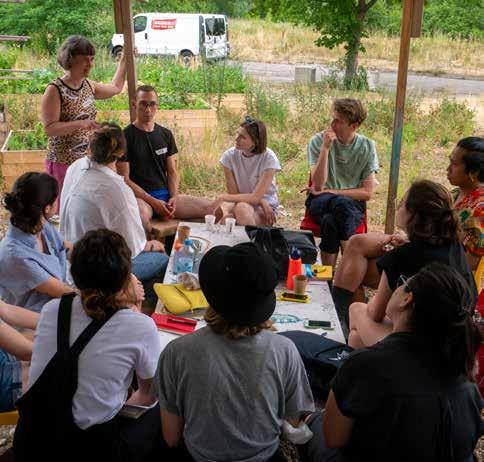
Echoing the course content itself, which asked how we can plan, build and put into practice cities that promote inclusion, the reflection and evaluation framework was conceived in praise of complexity and aimed to gain insights from as broad a network of participants as possible. Reflections by learners constellated the entire learning journey, as did the ones by the teaching staff, in addition to a broader set of participants who generously provided thoughts and advice during this last phase of the project. This multi-faceted process, revolved around the values upholding an inclusive teaching approach – as well as teaching about inclusion as a topic – and asked how such inclusiveness fared in terms of partnerships, inter-disciplinarity, blended co-teaching as much as the transmittance of course content and effectiveness of course delivery on such a critical (albeit neglected) issue for urban design and planning.
To validate the course’s premises and gauge the feasibility of its reiteration in the near future, several forms of data collection have been selected. As a result, a mixed set of evaluation methods featuring variable formats and targeting different participant categories was conceived and conducted (see pages 22-25). A first determinant characteristic between these different collection methods is whether they took place during the course’s implementationforming, in some cases, an official part of its curriculum – or whether they were organised as part of an a posteriori reflection.
A second distinctive element is based on the kind of reflection and evaluation moments, with meetings ranging from one-on-one interviews to transversal collective conversations including not only teachers and learners, but also additional participants such as relevant specialists who did not take part in the Practices of Urban Inclusion (PoUI) course as either learners of educators. In most cases, each course participant was able to voice her/his reflections in more than one way. During the course for example, learners took part in collective reflection moments (at local cluster level, as a larger cohort during workshops, or in mixed groups online during the pan-European meetings) but also developed their individual learning journal. After the course, they participated in an anonymous learner survey, but were also invited for an individual online conversation. The approach was therefore largely qualitative, aiming to triangulate between modes and perspectives.
Reflective Journals
Learners Teachers Additional
entire cohort
Focus Groups
Individual Interviews
Transnational ProjectMtg .
selection
selection (non-FG participants decided on case-bycase basis)
selection internal/ external specialists
selection (priority on non-FG participants)
course teachers
LocalCluster Meetings
local cluster
local cluster

The DESINC LIVE vision on learning was conceived as part and parcel of the PoUI course with the aim of articulating the convictions and beliefs that underpin the curriculum or programme design. Inspired by collaborative and feminist approaches which have aspired to underline how exclusion should not be underestimated in the context of learning and teaching, the manifesto was created to summarise the principles that have guided the course design, and to highlight the values potentially informing its implementation in the future. Such values were implicitly and explicitly discussed with learners, as well as being a returning point of discussion between the teaching staff.
Moreover, the manifesto itself was targeted during a mapping exercise included in the first Multiplier Event held in Milan in April 2022. It therefore benefited from the critical inputs of participants who engage with comparable issues and experiences in their own work, as CSO and/or as HEI representatives. Many of the comments from learners during the evaluation phase actually speak back to the manifesto and illustrate that several of its core values were on the forefront of what the teaching staff aimed to achieve and were recognized as worthwhile by the learners. Additional points of attention seemed to emerge from the question of language and the place that rolechanging can have in processes of learning together, which deserve to become more poignantly expressed in the manifesto.
Learning together: The course privileges ‘learning with’ rather than ‘learning about’. It elevates the voices of those who have experienced exclusion, and it cultivates mutual engagement, connection and collaboration.
“Doing together opens diverse channels of relations as opposed to traditional more language/ spoken word-based techniques of participation”
Unsettling hierarchies: The course intends to unsettle the hierarchies that are often associated with teacherstudent relationships. It values mutual learning and the horizontal exchange of knowledge and skills.
“We experienced a multidirectional inclusion and switching of roles – who is host and who is guest?”
Acting in space: The course celebrates spatial and urban practice as forms of enquiry and creative engagement with the city. It resists fixed disciplinary boundaries and promotes playfulness, exploration and experimentation.
“I learnt different ways of city making and new methodologies, everything is a process - from evaluating the current situation, reflection, concept to application.”
Making space for diversity: The course makes space for different bodies, voices, ways of knowing and learning modalities.
“The horizontal act of making becomes an inclusionary process (..) Our profiles were mixed and complex (students, migrants, foreigners, refugees, experts) and inclusion was a multi-directional path through many of life’s dimensions.”
Unlearning: The course supports deep listening and critical reflection. It encourages all participants (educators and learners alike) to be humble and to embrace the discomfort—and labour—of unlearning established ways of thinking and doing.
“The possibility to overcome ‘standardized’ architectural/planning output has allowed to reflect in terms of communication to non-architects, and thus in terms of impact and reflection among the local actors encountered in the live workshops.”
Embracing joy: The course embraces joy and laughter, and the acts of sharing, cooking, caring, playing, creating together.
“The horizontal set-up of the exchanges, the great feeling of trust between all participants in all kinds of relations (student-student, student-teacher, student-volunteer,...) helped make discussion and production joyful and respectful.”
Embracing difficult conversations: The course welcomes difficult conversations about difference, subordination and privilege. It cultivates the conditions for meaningful and respectful dialogue on questions of gender, race, class, ethnicity, sexuality, dis/ability.
“It was difficult to engage with people on site. What is their own space within the project? Is it our place to engage with them?”
Imagining possible futures: The course aims to experiment with how things can be done differently and to perform and produce urban change. It is inclined towards action and cultivates skills for critical, creative engagement with the city.
“How we practice in the city was reflected in the workshop (challenges of coming together, connecting across difference, different forms of knowledge and language)”





In dedicating part of its session to reviewing the Learning & Teaching Manifesto, the Multiplier Event in Milan set the PoUI course in dialogue with comparable learning and teaching experiences, gauging into how these related to the manifesto’s principles. Five of the total principles came under particular scrutiny in the course of the plenary discussion:
Learning together: The course privileges ‘learning with’ rather than ‘learning about’. It elevates the voices of those who have experienced exclusion, and it cultivates mutual engagement, connection and collaboration.
It is important to create a common terrain for learning together through the project – “making” the project therefore, becomes the main means to ‘learn with’ rather than ‘learn about’, which calls into question what we can consider a project in the context of each learning experience.
Unsettling hierarchies: The course intends to unsettle the hierarchies that are often associated with teacher-student relationships. It values mutual learning and the horizontal exchange of knowledge and skills.

Peer education is key, with shared tasks and responsibilities set during the learning process –mutual learning is reinforced through peer-to-peer exchange, while horizontality is reflected in collective decision-making on charges and undertakings.
Acting in space: The course celebrates spatial and urban practice as forms of enquiry and creative engagement with the city. It resists fixed disciplinary boundaries and promotes playfulness, exploration and experimentation.
Enhance a sensory experience of places and dive into space to question assumptions – experiencing spaces through more than one perspective and hence support the deconstruction of conventions and clichés
Create and design spaces that can favour immersive learning experiences – an understanding of space as a “lived”, socially-produced agent implies that the spaces actually hosting mutual learning environment are carefully designed inasmuch as the sites that may be explored in terms of future, imaginations and transformations.
Unlearning: The course supports deep listening and critical reflection. It encourages all participants (educators and learners alike) to be humble and to embrace the discomfort—and labour—of unlearning established ways of thinking and doing.
Breaking stereotypes makes room for creatively de-structuring knowledge – making mainstream categorizations and labels the explicit target of conversations supports the opportunity to experience their pervasiveness and, eventually, dismantle them.
The use of tools that help produce a deep understanding of spaces and issues also help identify instruments to apprehend space as a complex site of contestation is a critical step preceding any sort of engagement with a place’s transformation.
Embracing difficult conversations: The course welcomes difficult conversations about difference, subordination and privilege. It cultivates the conditions for meaningful and respectful dialogue on questions of gender, race, class, ethnicity, sexuality, dis/ability.

It is important to deal with conflict, trauma, discomfort – with migration and inclusion as key lenses to look into cities and territories, distress and struggles of various nature are inescapable and should be tackled first-hand rather than left unspoken.
Make educational offer available to wider community and study new ways to enhance participation – the digital platform and its offshoots can serve as a basis for increasing involvement and sharing the course’s teaching and learning activities with critical friends and more interested participants.
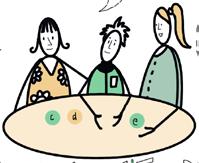
In setting the agenda for what should be different when learners would leave the PoUI course, the teaching team devised 7 Learning Aims and 5 Learning Outcomes which can be found here . Although learners did not relate evenly to all the aims and outcomes when invited to reflect on them both during and after the course, insightful remarks were plentiful in the light of refining the aims and outcomes for the future.
A wide majority of learners agreed that many of the learning aims were achieved by the end of the course. More specifically, 79,2 % agreed or strongly agreed that the course had introduced the relationship between migration and city-making effectively (Learning Aim 1). An overwhelming number of learners (95,8%) agreed or strongly agreed with the statement that the course exposed them to the complexity of real-life situations and questioned their position as a student, researchers or practitioner with regard to some complexity (Learning Aim 2). 83,4% of the learners responding to the survey agreed or strongly agreed with the assertion that the course had equipped them with terms and conceptual tools to support the exploration of diversity and inclusion in urban space (Learning Aim 3). Lastly, regarding Learning Aim 7, 91,6% of the survey respondents agreed or strongly agreed with being able to draw connections between the course and their own studies or practice, using it as a space for exploration and learning.
Learning Outcome 1, on the development of critical collaboration and communication skills, triggered important insights by several learners. In more general terms, the survey responses conveyed the sense that most course participants felt they had improved their
capacity to overcome language barriers, mainly through “speaking without words” and by finding ways to interact that did not require verbal expression as a basis for building relationships. As more than one learner noted, proficiency in “translating” became key: “we learned about how to translate not only between different languages, but also between different backgrounds of experience”, which resonated with a second consideration specific to the workshops where learners “ were in constant translation mode between different participants on site”.
Learning Outcome 3 emphasized the consequence of considering urban practice as an array of practices which could be set in relation with architecture, urban design and planning as well as social policy and work – and this to augment their possibilities as contributors to social and spatial justice. Together with the appreciation for the open and plural format of the live workshops, several learners valued the fact that these action-learning experiences were not geared towards the elaboration of a ”design toolkit”. Rather, as the words of one learner eloquently encapsulate the endeavour:
“how we practice across the city was reflected in the workshop, including the challenges of coming together, connecting across difference and bridging different forms of knowledge and language”.

Learning Outcome 4 focused on the experimentation with and critique of context-responsive methods and tools fit for transforming urban spaces in ways that are equitable and inclusive of the diverse needs and aspirations of all urban dwellers. The outcome was commented on by learners particularly regarding the struggle to situate their participation in short live workshops in the context of longer-term relationships that specific HEI and/or CSO partners had established with a specific site. What was the value of such immersive and intensive action-learning for longer-term partnerships and their potential impact on eventual site transformations? Through the learning journal, one learner, for instance, reflected on the ‘role’ of workshop participants and on the ‘performative’ character of the final outputs by asking: “Are we bringing visibility? Legitimacy? Is this our role/ contribution? If so, how do we approach it transparently? Who benefits from this?” Nonetheless, for some learners, despite the difficulty to understand how to match short-term involvement with longer timeframes of engagement by local partners, the fact that previous research had taken place and was offered as supporting knowledge was experienced positively, especially in the light of having to work at larger (macro) scales of analysis and projection.
In sum, particular points of attention when refining the Learning Aims and Outcomes consist of qualifying that the forms of critical communication and collaboration skills unfolded during the course have much to do with positionality and language. More specifically, shuffling between verbal and non-verbal forms of interaction, shifting roles and understanding the implications of such changes when interacting with different publics and spaces, as well as becoming proficient in various forms of translation appear as significant abilities that the course enabled participants to acquire and cultivate. With these learnings in mind, the course would benefit from revising Learning Outcome 1 to make such consequences more explicit. Likewise, being unequivocal about the relationship between “instant” projects and initiatives and the position these occupy in the context of longer urban transformation processes and partner engagements would help learners better situate, and consequently critique, the roles course participants and (future) practitioners take on. The question of being more time-sensitive also resonates with key suggestions from critical friends regarding the question of becoming more sensitive to time-related processes when addressing migration as a fundamental constituent of urban practice.
Develop critical collaboration and communication skills that mobilize different languages, forms of expression and translation, therefore expanding possibilities for interaction with a broad set of publics and sites.
Apprehend the significance of time in building relationships and how punctual, short-term actions relate and may support longer-term engagements with specific publics and sites, as well as match or dissent with broader urban transformation trends.
Lastly, as more of a fundamental interrogation that has been raised in the context of various moments of reflections by learners, teaching staff and critical friends alike, Learning Outcome 04 may also be revised. While the ambition of transforming urban spaces in ways that are equitable and inclusive of the diverse needs and aspirations of all urban dwellers is laudable, this point is seemingly in contradiction with the aspiration of doing away with vulnerabilities that specific groups may be experiencing, particularly when migration and inclusion are considered. Foregrounding a more partisan approach has its disadvantages, and the danger of stigmatization is always present, however several critical friends in the context of Focus Group discussions debated the pros and cons of being all-inclusive versus “taking sides”. With “dissensus” as a key topic taken up by the course, the latter option appears as more consistent to frame urban transformation as a struggle that is increasingly complex to build around consensus rather than on its counterpart. These considerations also bring into question how the activities, topics and methods of the course may be reconsidered in the light of findings that emerged from the pilot implementation in the course of 2021.
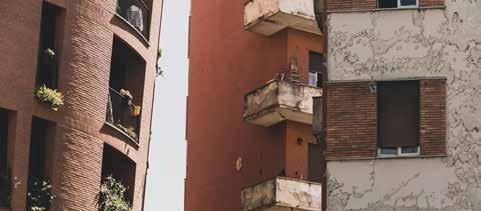
The PoUI course foresaw a significant array of activities to support participant learning throughout its duration. These included Live Workshops , an Open Knowledge Platform, Open Sessions, Personal tutoring, Facilitated peer-to-peer support, Critical Reflection as well as Learning Provocations and Public Dialogues.
From a learner perspective, the multiplicity of resources and undertakings was viewed as an asset in the context of learning about complex urban territories. As the survey results illustrate, the broad set of inputs as well as the abundance of skilled professionals making up the teaching and project staff, were valued by course participants. This was especially true when such variety was coupled with an “informal” approach to learning and teaching as part and parcel of a horizontal setup of exchanges which all partners seemed to share or were able to learn from one another in the context of working together. Several course participants however, experienced a form of fragmentation due to the many kinds of activities that were taken on during a course format that was neither an intensive short course nor a more self-paced learning experience. In hindsight, the combination of hands-on experience, theory-informed practice, and critical reflection that made up the PoUI course could have been more explicitly presented as three “pillars” under which the various activities would be reconducted to.
Although the course was from the outset imagined to be blended, most of the online resources and activities were viewed by survey respondents as under-utilized or as less effective than the live workshops and Personal tutoring sessions, and this despite Covid had provided a facilitating frame to enact these. As one of the teachers asked, “live workshops worked well, online activities less… how can we create a more inclusive learning environment across both?” There was a general agreement by both learners and teachers that, despite the effort to construct the Open Knowledge Platform,
this collective archive was hardly mobilized in the context of the course. On more than one occasion, learners voiced the need for a “broader frame” that could sharpen their knowledge of migration before being involved in the highly intensive action-learning moments in Berlin and Milan, and this despite the Open Sessions provided as topic-oriented preparatory ground to the Indeed, only 8 % of the learner cohort considered the blended format of the course as an asset. The materials made available online were not experienced as a particular asset because of their sheer amount, since the learners voiced a plea for orientation in the midst of such a vast offer of information. At the same time, the platform was not accessible to learners although it holds the potential to become a space of contribution from all participants.
In terms of affinity with the course’s main topics, 75% of the course participants who responded to the survey affirmed that inclusion was a key interest for them, and more than half (54,2%) considered migration as a significant point of attention. It is therefore meaningful in this context to note how more than one learner voiced an interest for a “broader migration frame” to act as a framing angle – this could not only help to better cope with the abundance of material, but also support learners’ understanding of the meaning and purpose behind the numerous activities composing the course. One learner for example, mentioned that in the context of Personal Reflections, “there was a lot of reflection within the course itself, e.g. was a tool helpful, but not always a kind of reflection that would help contextualize what we did in order to connect to broader migratory movements that are going on in the world, and politically position the course and DESINC network”.
“I wouldn’t say that everyone is interested in migration, which is why everyone should follow this kind of course.”
According to one of the critical friends who joined the Focus Groups, the call by learners for “more theory” or, in other words, a more effective “grounding of learning activities in theoretical, cultural and political contexts” is unavoidable in courses that place actionlearning prominently on their agenda. While there may be value in speedily moving into action, the provision of an elective selection of critical texts and reference categories for all participants to refer to was deemed as a key point to consider when replicating the course, especially if the target group of learners remains that of a differentiated cohort of participants. For future iterations of the course therefore, it appears useful to reaffirm hands-on experience, theory-informed practice and critical reflection as the main umbrellas under which all learning activities can be reconducted, rather than express these as a list of undertakings with no particular structure and/or hierarchy. What remains as an open question is how to relate them with one another for them to work as mutual supports rather than independent components. These decisions are most likely to be effective if taken on a case-by-case basis, depending on the specific focus and duration of the course, the social and spatial processes engaged with, as well as on the learner profiles and the partner institutions involved.

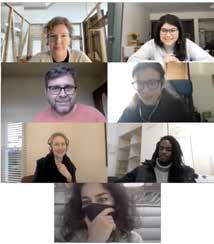
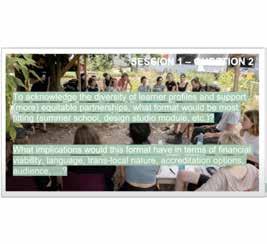
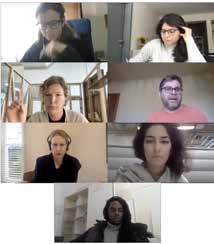
If Critical reflection is understood as a form of critically “looking back” to what is being done and experienced in the context of an action-learning experience, with the support of practice-based theory, then this pillar is a key tool for teaching and learning. Its potential may also become its limit, especially if the course will be replicated in a more condensed form, meaning that the time available to “reflect” and then to make such reflections manifest through a process which may be evaluated as a final output (such as in the case of the Learning Journal) may come with some challenges. However, if the Learning Journal is conceptualized and understood as an open-ended artifact produced by learners (individually and/ or collectively depending on the setting) and eventually assessed by peers and the teaching team, it can act as a critical sounding board taking up a variety of forms. Its open-endedness was however viewed as unhelpful for particular learner profiles, such as full-time practitioners or participants who did not receive formal accreditation for taking the course. Experience during the course showed that a tumblr website was an inspiring way to group collective discussions stemming from individual/personal inputs, promoting cohesion within a local cluster. A critical friend participating in one of the Focus Groups mentioned a comparable experience with student backlogs, suggesting that the combination of flexibility and constraint offered by a particular technological platform had proved effective to strike a balance between an “open” format and an overly predetermined one.
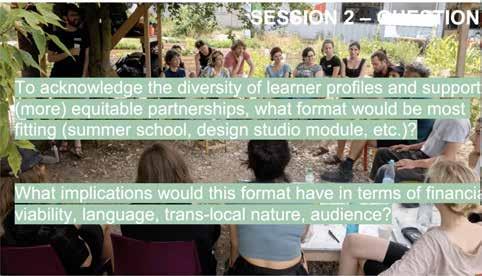



O P E N
K N O W L E D G E P L A T F O R M
Learning Activities
Critical reflection: Individual + group reflections + co-designed output (e.g. tumblr, etc.)
Learning Activities
Hands-on experience: Live workshops
Theory-informed practice: Lectures (open sessions, LPs & PDs)
Critical reflection: Individual + group reflections + co-designed output (e.g. tumblr, etc.)
Facilitated peer-to-peer support
Hands-on experience: Live workshops
Personal Tutoring
Theory-informed practice: Lectures (open sessions, LPs & PDs)
Collective discussions
Facilitated peer-to-peer support
Figure 8: Three Activity “pillars” within the Open Learning Platform.
Cohabitation
Care
Global migration
Urban practice
Space and power
Subversion and dissent
Social impact of the built environment
Governance
Ethics in the built environment
Crisis and resilience
Narratives of space
The Learning Journey is central to the design of the PoUI course. Its conception reflects the recognition that course participants joining the course would do so not only with diverging expectations, but also at different moments of their personal development. Moreover, because of their disciplinary backgrounds, geographic origins and varying relationships with their respective institutions or organisations, as well as with the city and country they were residing in at the moment of taking the course, a varied spectrum of support infrastructure would be required along each trajectory. Since the course was indeed being tested as a pilot, the teaching staff worked with personas to anticipate the profiles of learners that would participate in the learning experience. As stated in the IO1 report, the course designers “developed a series of profiles that reflect the range of participants that we expect(ed) to take part in the course. Describing the background and motives of everyone involved, helps us to tailor the learning activities to meet their specific needs and aspirations.”
Personas, as Sacha Costanza-Chock has commented upon, are linked to the idea of empathy in design processes. They are one of the many ways in which designers can imagine (or pretend to imagine) that through brief thought exercises, they can empathize with an “othered” subject” (in this case the learner) whose lived experience they often do not share. However, in worst case scenarios, CostanzaChock considers the persona process as a way of re-defining stereotypes or assumptions around a group of people that become paper “users”, especially because lived experience is nontransferable. When confronting the personas developed by each partner institution or organization, we do find that this admonition is of partial relevance. Not all the personas established found correspondence in the cohort that did end up taking part in the course, which featured a large majority of learners with a background in architecture (18/24) and/ or urban planning (7/24). The next largest group was represented by participants with a background in design and/or arts (3/24) and political science (3/24).
Although this repartition was, in some instances, experienced as an unbalance despite the ambition of the course to transcend conventional urban design language, simply because of the sheer number of participants (including the teaching team), it is important to take a step further when looking into learner backgrounds. At the midpoint pan-European meeting, when course participants shared some of their expectations, the picture that emerged was one of learners who were keen on questioning the tools that an orthodox architecture and urban design training may have provided them with until then:
Questioning one’s own training appears therefore as a crucial component of learners’ aspirations. Though the majority were trained in urban design and/or planning, their expectations resonated with one of the main principles of the Learning & Teaching Manifesto, namely that of “Unlearning”, which was also catered during the Learning Backpack exercise, proposed by a CSO partner. In the context of this endeavor, course participants identified objects that embodied what they had chosen to remove from their baggage of skills, and what they would instead add to it (For more details see IO2 Report).
The notion of support infrastructure was unfolded based on the abovementioned personas, and considered:
• Learners with no background in architecture or planning, who would aspire to deepen their knowledge related to the urban context, would appreciate group work and peer learning, as well as online materials and recorded lessons allowing for some flexibility
• Learners who, as migrating persons to Europe, are in the process of seeking asylum and are not proficient in the course’s main teaching language. They could benefit from translation support
“I wanted to learn about jargon – the jargon of planning creates exclusion –and how to subvert it”
“I wanted to make space for residents to tell their own stories and focus on their narratives”
“I wanted to learn about language – the language of architecture is narrow and restrictive, whereas practices of urban inclusion need to adapt and change”
(and eventually a glossary of key terms), easily accessible and understandable learning materials and platforms for their diffusion.
• Learners who would enjoy support to engage with the course’s more theoretical elements
• Learners who lack the experience of, and confidence in, collective working environments and would appreciate support to improve their capacity to do so
The learner survey and individual learner interviews confirm that the support infrastructure anticipated on the basis of the “paper” personas was fitting with regard to the actual cohort’s requirements when only one (or possibly two) of the above needs was actually present. By contrast, some critical issues can be recognized when learners looked for many, if not all, of the above points, requiring the co-presence of supporting infrastructure systems which was challenging to provide at once. When knowledge of several languages (but not the main teaching language of the course) added to the impossibility of travelling were combined with a background in one of the lesser represented disciplines and a lack of familiarity with group work, this resulted in learners who were “intersectionally disadvantaged”, an aspect which will have to be taken up fundamentally in the future.
Indeed, the factors that seemed to be more impactful on whether the support infrastructure along the Learning Journey was effective or not, were unequivocally dependent on the deeply set unbalances that migration policy confronted the course participants and the teaching team with. While the pandemic meant that several learners were hindered from participating in one or more of the live components, for learners who were also migrating persons in the process of seeking asylum, this opportunity was cut off from the beginning. As also anticipated in one of the personas developed to tackle such complexity, the learners whose condition resonated with that of asylum seeker Abdi (IO1 Report, p. 39) might experience communication challenges and would most likely not be able to benefit from the trans-local setup of the course. Both language issues and the unfeasibility to travel had indeed already been acknowledged by imagining Abdi’s challenges when taking the course:
He doesn’t have a passport and would not be able to participate in an international workshop. He wants to be part of this programme because he is keen to be more involved in local initiatives in Marzahn. At the same time, he cannot commit to anything longterm and often has to cancel commitments at the last minute.
Abdi wants to be an architect so this gives him an incentive to take part, but the organisers will need to be extremely clear about the aims, outputs and outcomes in order for him to fully engage in the course.

He speaks German but doesn’t speak English so he would need translation support and learning materials and platforms would need to be clear and easy to understand. A glossary would also be helpful.
As noted by one of the teachers, peer exchange was a form of support infrastructure that did play an essential role in bridging language differences. As one of the members of the teaching team pointed out, however, it was less successful in terms of improving the confidence levels of learners experiencing several challenges simultaneously e.g. course participants having both a different disciplinary background than the majority, and/or in the process of learning one of the main languages spoken throughout the course (English, German and Italian), and/ or unable to travel due to their status and/or nationality, especially as new Covid-restrictions vis-à-vis mobility came into the picture.
Improving and tailoring the support infrastructure along students’ learning journeys is therefore profoundly connected with the necessity to gain more precision in how the course is profiled, and the profile of learners it would aim to attract in the future. As such, considering
migration as an essential focus should not be automatically equated with including asylum seekers and refugees as part of the learning cohort - unless the support infrastructure set up in place can be tailored to the specific challenges that a migrating person would most likely appreciate. The course is otherwise at risk of reproducing within its learning environment the very same state-produced categories (asylum seeker, refugee, economic migrant, etc.) and the intersectional disadvantages that derive from these. Its accountability vis-à-vis its core values is also at risk.
In the context of the DESINC LIVE partnership two out of the three CSOs participating in the collaboration have a clear commitment towards the inclusion of migrating persons in cities (and beyond). Their involvement was also the result of having recognized, once the DESINC project was over, that implementing learning and teaching activities linking urban design with migration, should be consistent with the slogan first launched by disability justice activists: “nothing about us without us”. In this vein, the partnership was set up so that learners from CSOs and HEIs would all take part in the course despite several challenges. In the light of the challenges experienced, the intricate connection between learner profiles and profiling the course emerged as an essential question.
The section above has underscored how the relationship between the learner profiles and the profiling of the course itself is a challenging one, especially in the light of the experiences and the consequent reflections that learners, teachers, and critical friends have shared in the context of the course’s evaluation. A major recommendation which emerged during various exchanges pertaining to the evaluation process, was that the course’s engagement with the broad topic of migration would benefit from gaining precision and sharpness in preparation for its replication. More specifically, the way migration is posited was considered as deeply entangled with the course’s posture. As such, it also relates to the fundamental interrogations raised by some of the teachers concerning the kinds of inequalities that the course aims to address and, by consequence, also expressing consciousness about the fact that other unbalances may therefore be generated by maintaining a particular focus. This would also support the teaching team in ensuring that inclusion remains at the forefront of course activities, including the way relationships with one another are understood, the key terms that are selected for common usage and the ways to go about teaching. As one critical friend that took part in a focus group session persuasively synthesized:
This resonates at least in part with some of the remarks made by learners in the survey conducted after they had just completed the course. Several participants expressed the need for a “clearer migration frame” while others questioned the kind of migration that was being favored by the course, asking why the focus was not on the movement of expatriates or student flows, for example. Although dissimilar views did exist between participants on this note, a robust majority of the project staff and their peers involved in the focus groups argued against making the umbrella topic of “migration” too broad. As suggested by one of the critical friends belonging to a key CSO in the sector, a focus on the “vulnerable refugee” can also be problematic. A focus on design justice and a rights-based perspective on the other hand, could allow for more room to see how these rights become racialized through migration policy, and lead to questioning categorizations which the course should not reproduce. The challenge becomes then to envision how the course may contribute to erode a Western-centric perspective related to the idea that cities should be designed for the “vulnerable” or the “poor” who are often victimized or depicted as disenfranchised to the point of all agency being removed.
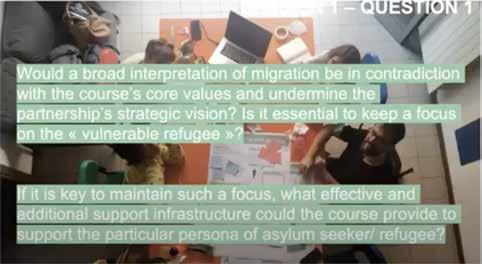
“If the course aims to be inclusive and maintain reciprocity as its core values, defining key terms is crucial as to avoid reproducing the problematic categorizations that are featured when it comes to dealing with migration (vulnerable refugee, poverty, etc.)”
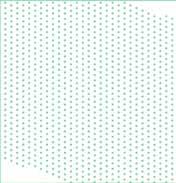
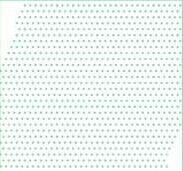




An experiment in education: replicability and dissemination
“Accreditation was important to me because recognition is important. The course consists of a lot of work, even if it's not focused on a conventional way of working and even if it's not evaluated in terms of grades. There should be a thorough reflection across the partnership on the topic of recognition, as an aspect that should be further developed."
The key question raised in the previous section about the course’s posture does not only impact the profile of course participants but also, in turn, the kind of recognition that can be concretized in the context of an HEI-CSO partnership. The plea from CSOs advanced after the pilot course was completed, was in fact presented as a sort of paradox to the partnership: for those learners who did not have formal affiliation to one of the HEIs as a “student”, it would be important to offer a comparable system of accreditation (or comparable benefits) – and thus make use of the formal environment of university systems – but at the same time “break apart” from their rather formal and inflexible structures of teaching and evaluating student performance. In practice, this double gesture requires significant institutional change. During the evaluation sessions the following points were touched upon:
• While all course participants received a certificate, only a part of them could obtain formal accreditation. HEIs that did secure accreditation for their learners did so either by including the course in their study programme or by accommodating it within their existing course system e.g. by making use of the infrastructure of “independent study” slots reserved for exceptional activities that do not take place on a regular basis, or making it a module within a design studio.
• The fact that VET learners could not receive formal recognition for their work generated some frustration, also in terms of making time when having to finalize course outputs (e.g. Learning Journal). The option of providing complementary incentives to that of recognition for VET learns is a major point of attention for any future version of the course.
Moreover, for learners who found themselves in a disadvantaged position due to language, training and/or the impossibility to travel,
the lack of formal recognition was an additional drawback. It also marked the difference between HEI and CSO partners and learners in unexpected ways and challenged the partnership to think further about how a replicable course could provide accreditation or an acceptable equivalent. The option of embedding an internship with CSOs as part of the course was put forward as a possibility, as well as that of offering the course in a language that learners might be in the process of learning, boosting their possibility to learn it actively and in a different way than conventional language classes.
“Perhaps it would be interesting to offer the course also in other languages than English (e.g. local languages: German, Italian, French, etc.) to allow for an active participation of learners from CSOs, especially migrating persons.”
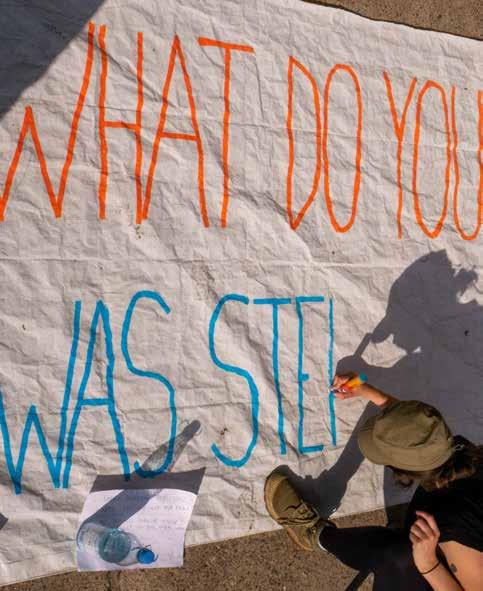
“One of the best sides of the course is to experience different realities and different cities. So this is something that would be really interesting to maintain if this course could be proposed again. Maybe a program with every year two different cities to understand differences through confrontation. To have different experiences was a very interesting part of the course, we had different realities to study.”
After the pilot offer several partners engaged with their local networks to understand how the course could take place in their most proximate institutional context. Most of these discussions occurred within HEI environments to explore how the course could be mainstreamed within the existing curriculum. In most cases, transforming the existing curriculum is a significantly ambitious objective, not only because of the challenge of achieving financial feasibility but also in terms of management and actual space available in an already charged academic programme. This was considered the first step towards making the PoUI course a replicable and refined product that would be ready for dissemination within the wider arena of HEIs and CSOs interested in developing it further and implementing it. The key points for this process were:
• To propose a more agile and compressed structure
• To maintain trans-local and multisited learning and teaching
• To improve support infrastructure for different learner profiles
• To gauge viable future formats for feasible replication
When thinking about the existing structures, initiatives, and practices of each partner institution, one of the options with most potential across the partnership consists of transforming the course into a course that is fully embedded from an institutional standpoint, as an extra-curricular workshop, or a largely independent short course or summer school. In the former case, it could become an accredited module that would be more compressed in its duration (and less cumbersome in terms of workload). It could also be included in an existing course or design studio and thanks to current or prospective bilateral agreements, could maintain the experience of moving to a partner university for a part of its unfolding.
Alternatively, the course could be hosted in spaces that transcend the existing curriculum. Some HEI partners, for example, have open courses offered to students to promote the development of soft and social skills through a cross-sectorial approach, to which a revised version of the course could be added.
A financially and administratively autonomous summer school was an option that various partners reflected upon. Despite a greater independence in organizing it, student recruitment would be a point of concern; while it may be easier for international students to attend, fees may also limit accessibility and therefore undermine some of the
course’s core values. Moreover, the chances of mainstreaming a selfstanding course as part of an institution’s regular curriculum on the long run, become slimmer.
In all cases, finding a way to replicate the course at Master- or postgraduate level was considered particularly attractive in more than one local context.
““The course means that as a learner I’m going to different places to learn in non-traditional ways about non-traditional methods. It offers this very horizontal learning situation, a bit experimental as well, which I think is interesting with people from all over in terms of where they come from as academic institutions, but also where they personally come from. I think that’s super valuable and super interesting, and I would definitely recommend to keep that. One thing that I really liked as well was the two-workshop situation because I think usually workshops are one. You go to one place and so on, but in this case it was also socially super interesting. You met all these people at the first workshop that you would at least in part re-encounter in the second workshop, which was also a super nice, interesting experience. And you’re in two different places. You get to see two very different situations, two very different approaches to the same topic that are still somehow connected. So in a way, you get to compare and contrast within the same topic. What are the different approaches?
What are the different ways of organizing these ? You might like one more than the other, you might take things from both, but just the comparison is super nice.”
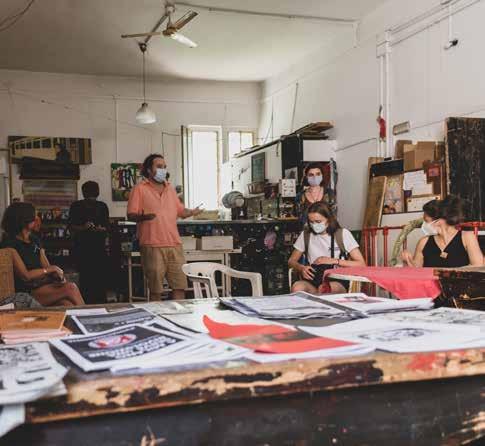

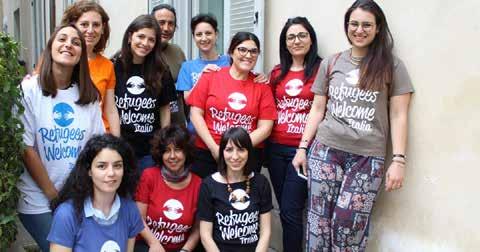
The refinement and simplification of the course’s structure, as well as a diversification of its support infrastructure, have been mentioned above as crucial to clarify the course’s posture vis-à-vis migration and the maintenance of its core values. They are also essential for the avoidance of accumulating disparities when targeting a broad range of learners including practitioners, academic students of various levels and migrating persons (which may overlap). The question of equitable partnerships between HEIs and CSOs (and any other organisations that in the future may be included in the context of the course’s reiteration) is at the core of the course’s design (and the DESINC LIVE initiative in the first place) and therefore also at the heart of its improvements. Although all partner institutions are aligned with the PoUI course’s overall vision, its implementation illustrated a variety of unbalances that need to be addressed to allow for the course to run again in the future, especially in relation to HEI-CSO unbalances.
Indeed, in turning again to Sacha Costanza-Chock and her discussion of design justice, the clear alternative to the dangers of approaches based on quick and “empathic” thought processes is “to partner with well-established and long-standing community-based organizations that have history and recognition and deep ties and accountability to
“The vision of the course, built on changing the narrative around migration, fits with the mission and work of Refugees Welcome Italy”Figure 16: Refugees Welcome Italy accompanies the integration process of refugees through different projects including placement in host families. Photo RWI
communities one may not have lived experience with and work with them from the beginning through all stages of the design process”. The CSO partners participating in DESINC LIVE undoubtedly correspond to such description and offer therefore the best possible opportunity to voice concerns over their continuous participation in the forthcoming future of the course. This implies creating room within any potential budget for the running costs incurred in their work, as highlighted by certain members of the teaching team during the TPM in Brussels. Moreover, the course can significantly improve in its nimbleness and adaptability to better match the timeframes and modes of working of CSOs centered around migrating persons.


Continuous engagement and teaching for instance, were considered as challenging to perform without funding and, even if the latter were secured, would anyhow be hardly accessible to participants connected to the CSOs. Similarly, securing teaching time for staff is a challenge for HEI personnel as well, even if tenured. Within the objective of maintaining a trans-local, inter-disciplinary, multi-sited and co-taught learning and teaching experience, it was deemed as

crucial to simplify the course framework to accommodate the needs of non-HEI participants. More generally, for all partners a common and simpler framework would be an essential step for replicability, with a better understanding of what it takes to do what and whether this is accounted for e.g. site preparation.
Framing the course more equitably would also mean avoiding a dominance of HEI formats and encouraging separate stages, a more compressed timeframe with multi-sited workshops as optional (but trans-locality and co-teaching would be guaranteed through guest lectures, eventually online). Block teaching with less meetings and “in-between” moments was seen as advantageous in this regard, with an attention to placing the live workshop as a key catalyst for relationship-building and should therefore be placed at the front end of the course’s unfolding. Co-teaching setups would then take place within focused timeline and timeframe. Another important point raised concerned the cohort as essential contributors and co-producers of the learning and teaching experience, considered as a “community of practice” vital for the expansion of the network. Their role also became clear during the major dissemination tools for the course, namely the Multiplier Events that were held in Milan, London, Berlin and Brussels in the Spring of 2022.
An additional point concerning the challenge of securing an equitable partnership such as that aspired to in the context of DESINC LIVE was to inform the learners of the structural differences within the partnership. This allows to be more explicit about the unbalances and would be considered as a part of being exposed to “real-life” challenges. This would also be a way to address the challenges/ opportunities embodied by the short-term involvement of action-
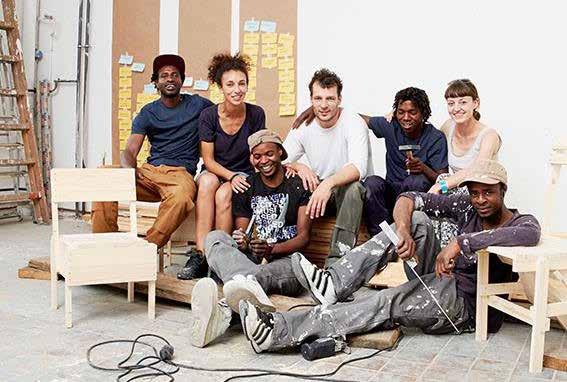
learning experiences such as live workshops within longer timeframes of engagement and provide some answers to a question raised by many learners alike: how may a punctual but intensive endeavour contribute to the reinforcement of a long-standing partnership? The words coming from one of the more experienced course participants who had already met the challenges of critical practice and actionlearning are meaningful in this regard:
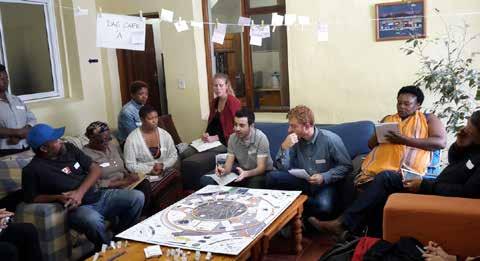
“It was interesting for me to engage in a bit of a similar thing (to my past practice), but in a completely different context and also in a framework that I hadn’t participated in setting up at all, so plugging into something that was already kind of framed. And so I think for me it was interesting to have less of a teaching or executive role, and rather to be immersed in it, and to have a bit more space to reflect on this particular point, of what is the role of us building here, what is the process through which we make decisions to build something. What is our contribution here? Is it really about what we’re building? Is it about bringing visibility and a bit of legitimacy to a place? The workshops for me were about reflecting on how do we engage and what do we engage. What is the purpose of us as a kind of academic institution and learners and so on? What is the role of us engaging in these contexts that have been marginalized and that have been delegitimized, and what are the different ways in which we engage?
I’m in line with the idea of the course that actually questions what learning is and what is engagement.”
Four multiplier events were set up in the Spring of 2022 to pursue the aim of consolidating and expanding the network around the DESINC LIVE experience. This meant starting or continuing dialogue with prospective partners and like-minded initiatives, especially in the case of the local clusters who had not had the chance to offer a live workshop for the entire cohort (London) and who had not had the chance of working closely with a CSO partner (Brussels).
Each Multiplier Event had its own flavor according to the objectives it strived to achieve although some commonalities around the promotion of the learners’ work (even when individual projects extended beyond the course’s timeframe but originated from it) and to rely on graphic recording as a main form of synthesis of each event’s contribution. The events’ descriptions and related graphic recordings can be found below:
The first event took place at the Politecnico di Milano and hosted about 30 scholars and members of CSOs. Their experience can provide a starting point for a joint reflection on innovative teaching and learning and the possibility of cooperation among academic and non-academic partners. The Milan multiplier event gave room for reflection on the course itself, the replicability of such experiences, and methods and tools of innovative teaching in learning frameworks based on cooperation between HEIs and CSOs. The interactive activities organized by the Italian team aimed to answer the following questions:
• How did learners experience the course proposed during the project? What did they take out of it, and what innovative features did they find?
• Which keywords best describe innovative learning experiences,
such as the “Practices of Urban Inclusion” course? What features make a learning experience different from traditional, academic teaching formats?
• How do we think about (or rethink) the evolution of teaching through the collaboration between High Education Institutions and Civil Society Organizations? How to best engage local stakeholders in their role as co-actors in an innovative learning path?
• How can we create the conditions for further replication of the educational offer?
After a welcoming moment and an ice-breaking activity in which attendees were asked to provide their definition of learning based on their teaching and professional experience, the coordinators of the Italian team (Francesca Cognetti – PoliMi, and Giorgio Baracco – RWI) described the “Practices of Urban Inclusion” course. They highlighted some challenges and tensions that occurred while developing this educational experience.
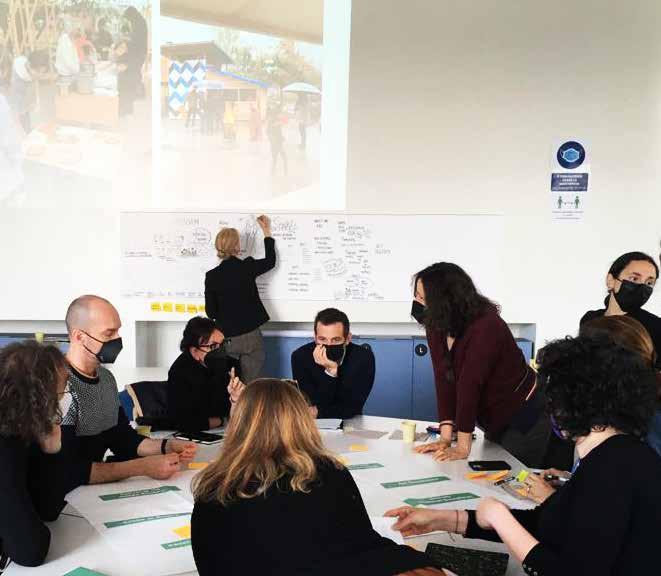
Some significant points were stressed, such as the horizontal and experience-based learning proposed by the course, which is based outside the classroom and rooted in long-standing research; the interdisciplinary and culturally diverse community of learners and teachers, which fostered an enriching environment; the possibility
Practices of urban inclusion: Towards a Learning & Teaching Network
of developing new skills for architects, urban planners, and social workers in fragile contexts. The coordinators also addressed the challenge of creating educational paths capable of training a generation of future planners that are more sensitive to the issues of making the city more open to migration.
Two learners were also involved in the presentation and described their direct experiences. Their presentation focused on two main questions: What is the role of designers in shaping inclusive urban practices and designing a more equitable city? Is it possible to imagine different, more open, inclusive, multidisciplinary, and horizontal ways of learning? They described their educational path as interdisciplinarity, horizontality, and variety in the proposed activities. Therefore, they offered a “toolkit” to design urban inclusion based on making (new spaces and new forms of joint intervention in public space), storytelling (by listening to people and narrating the city differently), and sharing ( sharing knowledge and competencies, but also creating moments of co-design).
After the course presentation, the audience was asked to reflect on the values and principles that the “Practices of Urban Inclusion” course proposed. Suggestions and comments arose about all the principles of the Learning Manifesto (see course prospectus) that helped further explore the offer brought about by the “Desinc Live” project.
An original contribution by the audience centered around the necessity of engaging over time, i.e., creating the conditions for making the educational offer consistent in the long run and adjusting short-term and long-term outcomes and expectations. Issues of cooperation between academia and civil society were also raised with regard to consolidating an offer that is mutually enriching and thought-provoking.
The event ended after a brief discussion about the potential replicability of the educational offer. The audience discussed the importance of replicating this teaching format and expressed the will and availability to develop the course further.

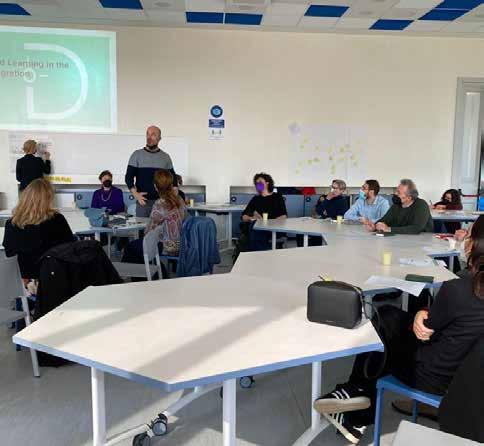

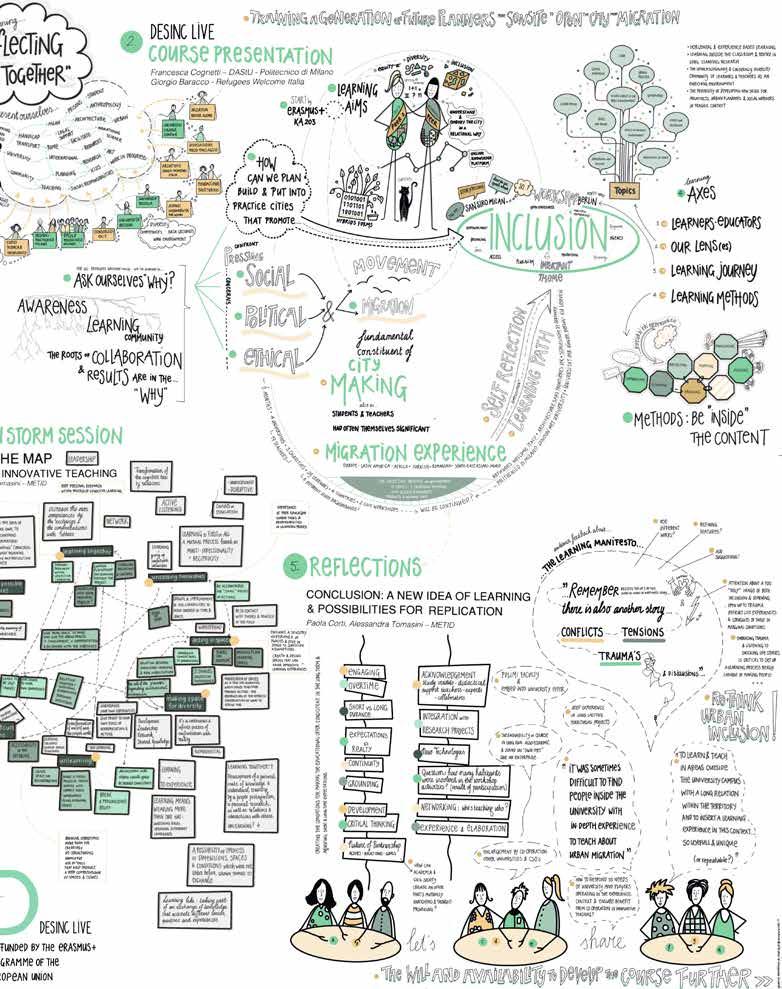
On Monday 16th May the festive event titled “Common Ground for Urban Inclusion” to too place with a threefold aim: to share the design and delivery of the new PoUI course, to build a network of potential collaborators in London, and to explore opportunities for implementing a future version of the course. Stakeholders, students, and practitioners were brought together by London Met’s Art, Architecture and Design School and the non-profit organisation Architecture Sans Frontières UK. The event, held at St Luke’s community centre in Islington was especially aimed at building a network of peers in London with an interest in migration, inclusion, and city-making. Across the room, it was clear that everyone was very happy to be part of a face to face event after nearly two years of virtual work.
The evening focused on how education and research can better equip built environment disciplines to address urban inclusion. Beatrice De Carli and Lucia Caistor-Arendar, both London Met researchers, co-hosted the event and opened the evening with a presentation on the innovative pan-European course, Practices of Urban Inclusion. The course has been developed across four European cities and centres around issues of inclusive city-making in the context of migration. Three of the London Met students who took part in the programme were at the event, and their work was displayed on the side of the room in bright, bold colours. A highlight of the pilot programme was bringing a variety of different disciplines together, not just architecture. Students with backgrounds in art, design, playwriting, journalism and more, were able to share their
Practices of urban inclusion: Towards a Learning & Teaching Network

knowledge and approach the issue of inclusive city-making from all fronts.

Agnes Fouda, a student on the programme, created ‘Migrapoly’, a twist on Monopoly that highlights migrants’ journeys towards settlement in London. Agnes joined the course through London Met: “I applied because I’ve always been interested in migration. Throughout the courses, lectures and projects I’ve learned way beyond the scope of my own discipline. I have come out of the course totally changed, it has been life changing.” Since doing the course, Agnes has been awarded a Fellowship in Venice during the 2022 Biennale to continue exploring these themes.
Pooja Agrawal, a highly experienced architect and planner, co-founder and CEO of Public Practice, also spoke at length about inclusivity in architecture and design. Speaking about the event, Agrawal said: “It’s really an honour to do something in person and in London. It feels like a really nice moment to see everyone and to talk about inclusion, something that is really close to my heart.”
Rae Goddard, a graphic illustrator and Aysha Aktar, a student from London Met’s Hyper Studio, documented the event live, creating a wonderfully rich visual summary of the session. Anne Markey, Interim Head of the School of Art, Architecture and Design, was also in attendance: “It is so nice to see a number of different services and stakeholders come together. It’s also great to step out of the University walls, by holding it at a community centre it makes it feel like a more cooperative event.”

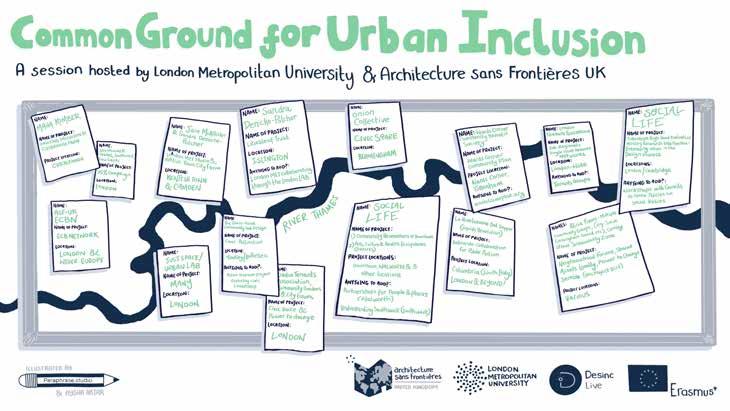
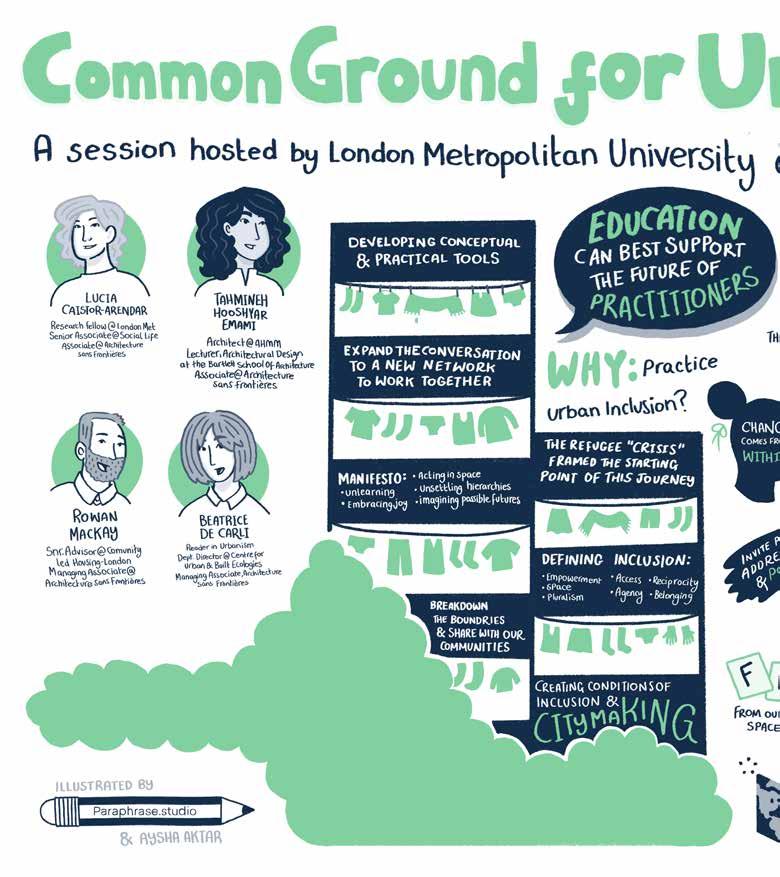

On May 20th, S27 - Art and Education and the University of the Arts (UdK) welcomed over 30 people, who came to Marzahn to attend the Multiplier Event in Berlin. The attendees had the chance to experience a compact version of the week-long workshop that was part of the PoUI course. In this way, they could discuss urban practices and learning experiences while walking, building, or cooking while sharing (more than) a meal.
Building on the multiplier events that were held in Milan and London, the German local cluster organised a local event aimed at disseminating the outputs from the project, showcasing the learners’ work and practice, while also connecting to local networks and further experimenting with ideas and tools from the workshop that took place between June 28th and July 4th 2021. The multiplier event in Berlin was therefore conceived as an experimental symposium. It was structured around parallel workshops, in which participants could engage with local actors, PoUI learners and teaching staff through hands-on, interactive activities: community cooking, making “Hackenporsche” (shopping trolleys) and walking. The event was named “Fun Fair Marzahn” to remind the audience that the premises upon which Stadtwerk mrzn has been built used to be a fun fair, before turning into fallow ground, but also to hint at the playful and multifaceted learning opportunities around which the multiplier event had been structured.
Before starting the interactive part of the day with three workshops, Vera Fritsche from S27 - Art and Education and Katharina Rohde from UdK welcomed everyone and gave a brief introduction of the PoUI course. They especially stressed the role of the two on-site workshops (Berlin and Milan) as a learning experience that holds potential for students of architecture as well as other disciplines. They also highlighted the importance of cooperation between HEIs and CSOs to create new and ideally more diverse learning environments.
The team of Stadtwerk mrzn and some of the learners contributed to the introduction, presenting Stadtwerk mrzn in the context of Berlin. As a project located in an industrial area on the outskirts of the city, its relevance for a community of people affected by precarity, liminality was discussed, as well as its role as “construction site” and experimental space for children, young adults and grownups undergoing a process of marginalisation. They also gave an overview of what had been produced during the course: some of the structures standing at Stadtwerk mrzn are the tangible result of the 2021 workshop and other outputs, such as videos, pictures and publications, were also exhibited on site.
Practices of urban inclusion: Towards a Learning & Teaching Network
After this first common introductory session, participants split into three groups for the second part of the event, i.e. the workshops, with the aim of coming together again after 2 hours for lunch. Although each workshop had two leading experts, the activities were structured in such a way that hierarchy was flattened, and the exchange took place at all levels. Each participant contributed with his or her own specific expertise, perspective or even questions.
The community-cooking workshop was organised in cooperation with a group of Afghan women living close to the site of Stadtwerk mrzn. Whereas the ideas for the recipes came from this specific group, workshop participants had to team up and take ownership of processes, determining in which order ingredients had to be prepared, discussing the cooking steps, and dividing tasks adequately among them. They found themselves chopping and cutting, roasting and baking and, ultimately, caring for other people attending the event, `while reflecting on how learning is generated, what a “good” learning environment is made of, what is essential to learn and how this connects to questions of solidarity, resilience, individual localisation and connection.
At the same time, another group was designing and building shopping trolleys, while discussing what one leaves behind and what one takes with her/him self after an intensive on-site engagement. The shopping trolley was the concrete metaphor of the learning journey, but also tapped into the experience of some of the people who live next to Stadtwerk mrzn and use a shopping trolley on a daily basis. Between hammer bangs and drilling, important questions

arose: What are the limits of engaging in a marginal context? What hopes and expectations does such an intervention create, and what disappointments are likely to be generated? What do we learn from temporally limited activities and how can one best engage in contexts where people’s everyday experiences tend to be liminal?
In parallel, another group of participants joined an explorative walk, during which they were invited to discover the surroundings of Stadtwerk mrzn and question issues of centrality vs. periphery, public vs. private and places of inclusion/encounter vs. exclusive places. This group also debated the method of learning through walking (including observing, smelling, touching, hearing, collecting items) and walking as an academic or scientific praxis.
The event ended with a common meal (prepared by the community cooking group, but enriched by ingredients – mostly herbs – brought back by the walking group). During this time, participants had the possibility of further exchanging and comparing experiences in an informal setting.
Overall, more than 30 people of different origins, ages and educational backgrounds came together at Stadtwerk mrzn. Among them, some were urban practitioners and a large part were social work students who acknowledged the potential of a course devoted to urban practice and inclusion, representing a potential target group when assessing the replicability of the course.
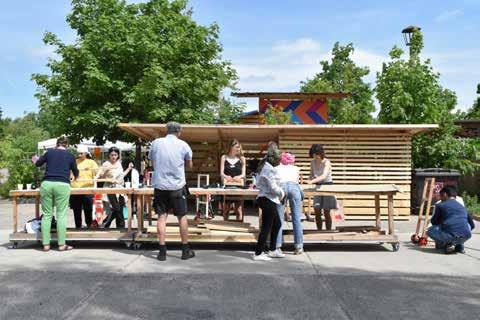



The last event took place in an off-campus location in Brussels called DK, which is also a temporary occupation in the city, providing a suggestive setting for discussions linking design, migration, and inclusion. The first session centered around the question “Can We Design Inclusion?” that was also chosen for its title, and which was expected to work as a red thread throughout the event.
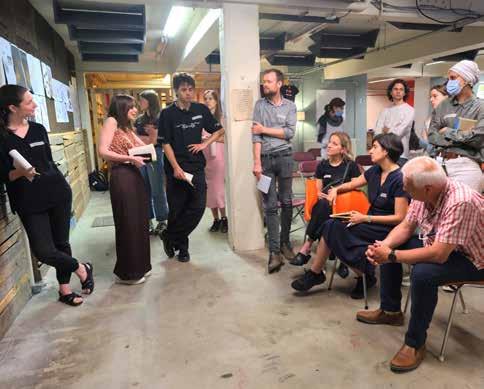
To set the scene, an introductory presentation showcased the work done so far by the DESINC LIVE partnership. It relied on part of the insights gathered from the first evaluation steps to start framing some of the major interrogations that had emerged in the context of HEICSO partnerships, including the challenges of aligning timeframes, the legacies of “live” initiatives and the diversification of support infrastructure to cater for a broad range of learner profiles. Using the presentation as a backdrop, two learners shared key takeaways from their experience of the course with the audience.
The event then moved to tackle one of its key aims, namely that of better understanding the work generated through partnerships between CSO members and university colleagues focusing on urban inclusion in the context of Brussels. This was firstly done by working on mapping their role, place(s) of concern, and ongoing collaborations, and secondly by apprehending these thematically.
The discussion of Brussels-based experiences and initiatives was clustered according to two thematic sessions: “A Space in the World” focusing on Shelter & Asylum initiatives and “Claiming Place” focusing on Occupations. These were recognized as being two sides of the same coin when it comes to the presence of migrants in the city, and as such were considered both central for achieving an overview of initiatives, projects, strategies – and related stakeholders – in Brussels.
Each of these thematic sessions was conceived as an interplay between practice-based research and action-learning in the form of on the on-hand, short pitches by practitioners probing into the role of design for inclusive cities, and on the other hand, succinct research pin-ups by action-learners who conducted fieldwork in sites such as asylum centers, homeless shelters, and squats. In the former case presenters summarized some main takeaways around inclusion that practitioners saw emerge in the context of their practice, while the second set of mobilized the exhibition of final thesis work to reflect further on the spaces that migration produces in a city such as Brussels.



In both kinds of presentations liaisons with grassroots initiatives were critically explored as a way to further apprehend the space claimed by solidarity networks in Brussels. Two large-scale maps of Brussels, each documenting one side of the abovementioned coin, were available as a working base to expand and (better) situate the discussion.


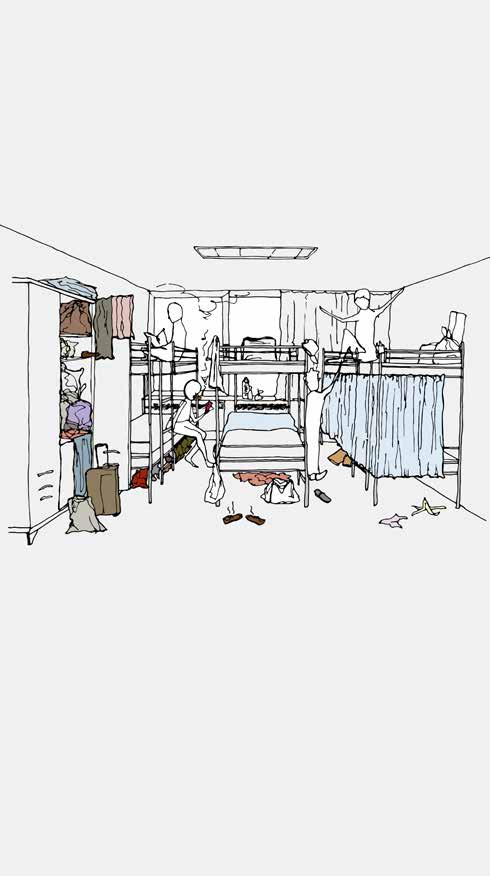


An experiment in education: (re) designing Practices of Urban inclusion
The conception and implementation of the PoUI course is indebted to the work that the DESINC partnership initiated in 2015, which started looking into the challenges that architectural and urban design teaching were facing when tackling migration as a core topic. While exploring the issue of terminology and the ensuing discriminations that the use of certain categories inevitably represented for migrating persons, the partnership advanced a multi-dimensional and rather open-ended delineation of “inclusion”. The IO1 report picked up on this definition once again, underscoring the fact that inclusion is a contested term that carries distinctive meanings for different people. From inception, the team agreed to avoid a singular definition of the term, but preferred to suggest words and ideas that, over the course of our collaboration, had prompted reflective conversations whenever the notions of inclusion and migration were set in dialogue. In all instances, learners, readers, and other critical friends were invited to consider the list dynamic and contribute to its revision/ integration. Aligned with this incitement, this report considers the contribution of those learners who, through in-depth individual interviews, commented on the idea of inclusion, considering these reflections as extremely precious for re-thinking the course and its foundational terms and posture.
“What is inclusion ? It is not integration. I can mostly say what inclusion is not.”
“What inclusion means is the biggest question. I think the PoUI course in a way did broaden it and I think it’s about asking: what can we do with our practice? What kind of paths or directions or possibilities of practice are available? Which are an option to think about in the disciplines that we represent?”
“It all starts with the system and the politics around migration, but I think that inclusion should not be like “we’re going to include them.”
“Sometimes I feel like inclusion is a bit limited. When I think of inclusion, I have a similar reaction to when I hear of participation; I feel like there’s this central position from which you include others. So I think I have mixed feelings about it. I feel like inclusion is described or discussed from a central position or like you are the one including others.”
“Let me say inclusion is how when you make a soup, you have that pot, that pot on the fire, and each ingredient brings flavour to the soup. Inclusion is being able to be part of that. It’s about being mixed without spoiling the soup and without the other ingredients spoiling your status as either a vegetable or whatever your ingredient status is. That’s what I think is inclusion. It’s a constant tension between giving and being given. Not being cut either from your roots or from your new environment. Embracing and being embraced.”
“To begin with inclusion, you have to analyze a lot. You can’t really put yourself in the place of particular persons and you can’t understand. So in the course we were analyzing, we were researching, but we weren’t really designing yet. To actually design inclusion, you would not only need all these disciplines to get together, but you would also definitely need more time.”
“When do we draw the line between inclusion and exclusion? Because it is a problem that you will see the consequences of.”
In the last stages of the project, the DESINC LIVE partnership asked itself on what grounds the course could be continued not only at the level of each local cluster, but also as a partnership-wide endeavor. During the individual interviews, some learners reflected on why the course should be continued and what should be considered its essential components.
“You should take this course because you will try an innovative way of learning that probably learners never tried before. You won’t feel judged, you will be finally free to express yourself and be encouraged in the right direction without negative judgment or yeah, competition, negative competition or everything we are used to. I mean, at least I am used to.”
“A reason to take the course is that you will be in contact with a lot of different realities and of people coming from different backgrounds and this will help you a lot when thinking about design and thinking about the city in a different way, about all the networks of people that work in the city and that can have an impact on the development of the city. It’s really interesting from the relational standpoint : you will meet so many people coming from different backgrounds so engagement and inclusion start from within the course. You will experience the multiculturality of cities, of inclusion as a theme and of inclusive cities. Having many people coming from different backgrounds is in itself the first exchange that you will experience.”
“I found the framework of learning quite interesting because it questioned what learning means, what the context of learning is and what kinds of things can be learned and how it can be learned. I found the format also quite interesting, with the idea that it wasn’t a workshop as an extension of traditional university
During the Transnational Project Meeting in London, the DESINC LIVE partners also explored what essential and desirable aspects of the course they could keep sharing as one of the several outcomes of their collaboration. They agreed on a refining a shared framework of values and principles, related to the conditions required to run the course once again, beyond its pilot phase, and that the partnership is committed to replicating in its improved version. In terms of the course itself, beyond the more detailed evaluations available in the preceding pages of this same report, the following conditions were deemed as desirable for the course’s replication:
• Shared trans-local and multi-sited engagements
• Inter-disciplinary approach and collaborative co-taught components
• Hands-on experience, practice-based theory and critical reflection as key pillars
• Establishment of partnership agreements confirming commitment and clarifying level of involvement
• Peer-to-peer support coupled with a more simple and agile course structure
• Tailored curation of an interactive collective archive based on context-dependent challenges
• Workshop themes bound to the needs of CSOs that act as “challenge-posers”
• Simple assignments/ outputs co-designed by learners and teaching team
• Introduction of alternative benefits beyond credits (e.g. internships, language learning, thesis exchanges,...)
Beyond the replication of the course itself, the most important outcome of the partnership was that the partners were keen on keeping their alliance alive and viewed the course’s reiteration as one of the several results of their like-mindedness and collaborative experience. While the partnership committed to replicating the
learning, that is usually very vertical and pretty established in terms of what is to be learned and how it is learned and from whom one learns and in which context and so on. So I found that super interesting, as well as the focus on going to different places and emphasizing migratory backgrounds and migratory conditions.”
PoUI course in the near future in a simplified and shorter form, they more significantly agreed on upgrading their partnership to an actual network. This process was also the result of the quality of the cohort that actually completed the pilot version of the course as a key resource for the network’s consolidation, as well as for the dissemination and replication of the course itself. The partners therefore agreed to pursue work together as a network that would benefit from (re)naming itself, re-balancing HEI-CSO relationships in all joint activities, and withholding their involvement both in the form of local clusters (which in some cases needed to be reinforced or initiated e.g. Brussels) and as a broader pan-European collaboration.
In the context of the course and comparable joint activities run by the local clusters and/or pan-European partnership, the CSO members underscored the interest of becoming more explicitly responsible for identifying the topics and sites for researchers to tackle, which would generate an immediate benefit for their respective organizations. As an additional noteworthy point of agreement between partners aligned with the intention to re-balance HEI-CSO relationships, the option that HEIs would take up the financial and administrative burden of organizing activities such as the PoUI course was considered. Beyond proposing the key challenge to be tackled, in the context of the course’s replication, the CSOs could become heavily involved as collaborators at specific key moments (workshops, internships, collaborative teaching, etc.) rather than having to recruit and support VET learners.
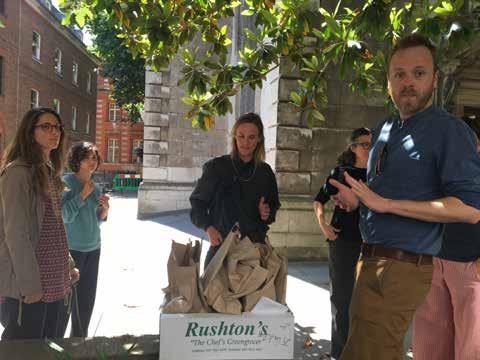
The consolidation of the partnership as a living network will be based on a rotating responsibility to nurture the collaboration by hosting meetings three times a year, collaboratively upkeeping the collective archive, subscribing to a joint Memorandum of Understanding or Partnership Agreement, identifying key action points and proposing a vision for the future. Additional activities such as a joint book project and a journal article are noteworthy on-going collaborations that the network is advancing, and that will further support its consolidation. All of these collaborative iterations, as well as future iterations of the PoUI course, will take place within a jointly shared framework of values and principles that the network subscribes to, leaving room for adaptability within each local cluster.
Practices of urban inclusion: Towards a Learning & Teaching Network
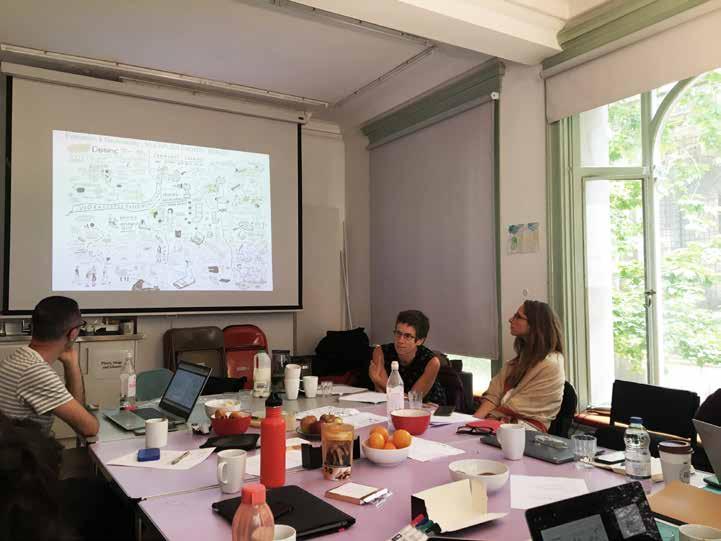
The Glass-House Community Led Design
Sheffield Hallam University
Westminster University
London Borough of Tower Hamlets
Social Life
DESINC Partners:
[HEI]
Current Potential Previous [CSO/Public/Private]
Current Potential
Latin Elephant UCL
London Metropolitan University
Architecture Sans Frontières UK
Public Practice Paraphrase.Studio
University of Sheffield
ARUP International Development
London School of Architecture
Allford Hall Monaghan Morris
Studio Gil
muf architecture/art
Matt+Fiona
Part W
Practices of urban inclusion: Towards a Learning & Teaching Network
VUB
EPFL UGent
Collectief Goed
KU Leuven
UC Louvain
Collectif Zone Neutre
RuimteVeldWerk
Alice Salomon Hochschule
Universität der Künste Schlesische27
Alida Schmidt-Stiftung
Iniziativa Never Alone
Sapienza University
Bocconi University
Politecnico di Milano
Refugees Welcome Italy
CODICI Ricerca e Intervento
ASF Italia Terzo Paesaggio
Avanzi - Sostenibilità per Azioni
Fondazione Soleterre
Comune di Milano
Shifton
The appendix includes the following documents:
1. Survey Results
2. Focus Groups Participants
3. Multiplier Event Attendee Organizations
4. Individual Interviewees
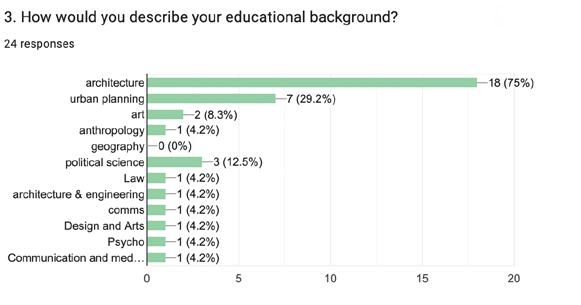
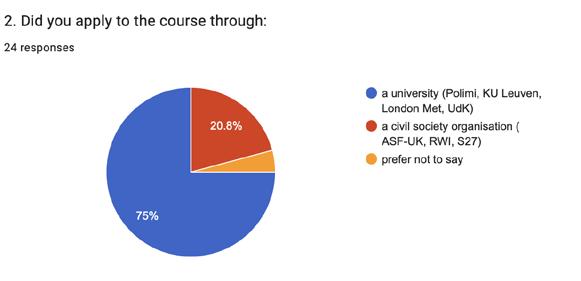


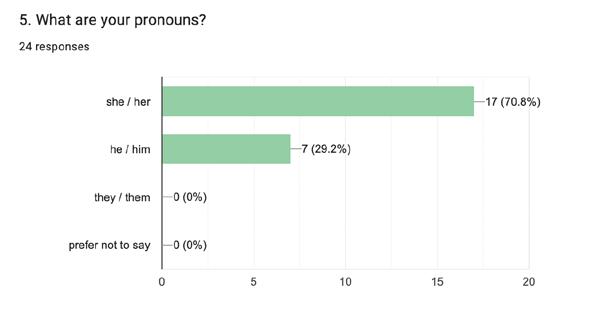


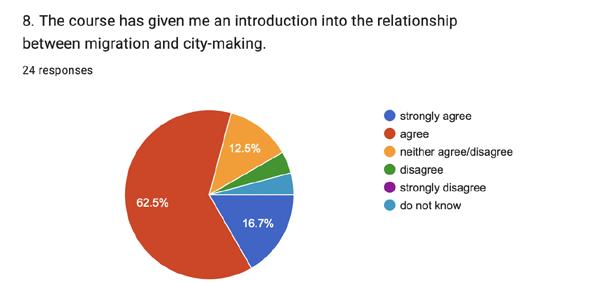

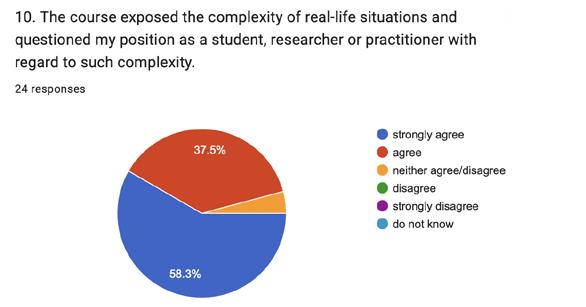

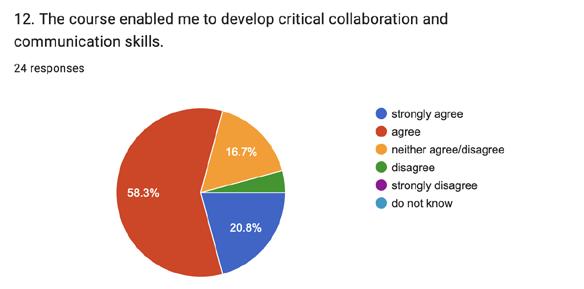
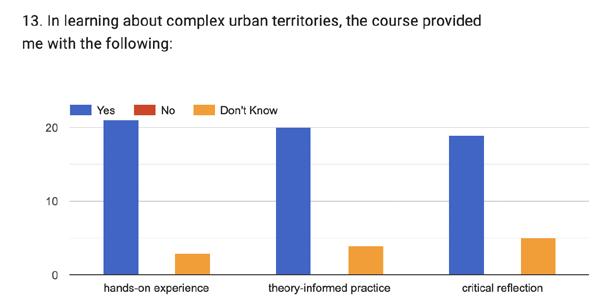






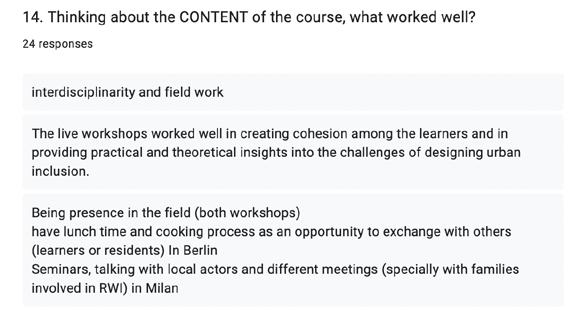

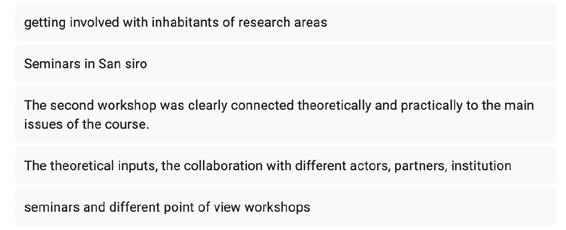





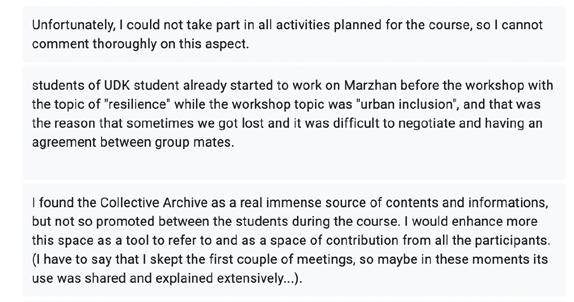

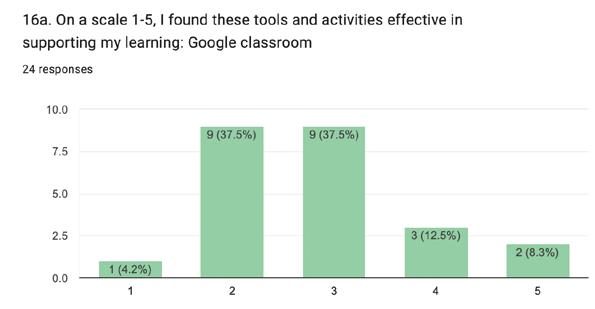
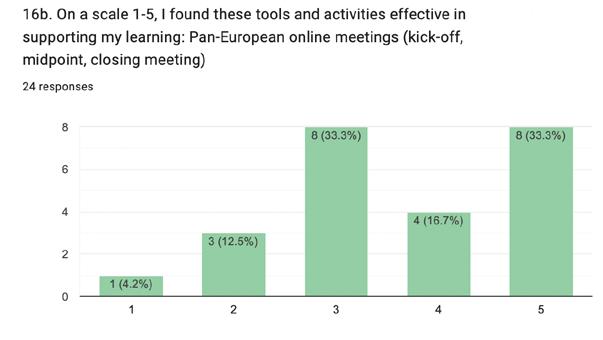

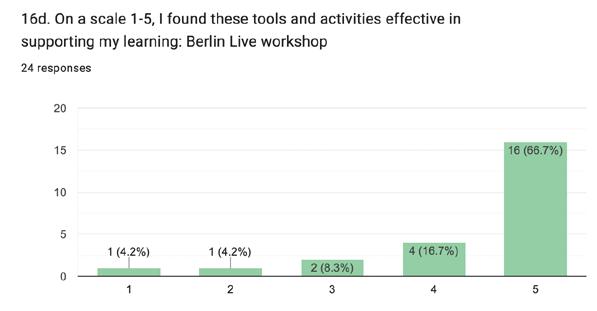






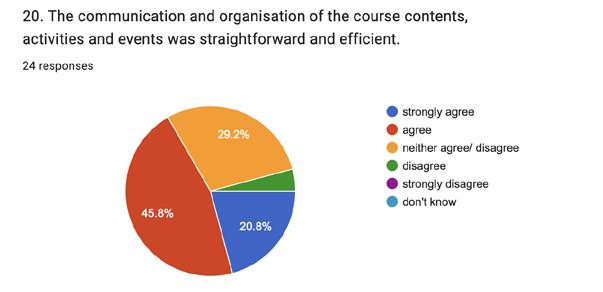

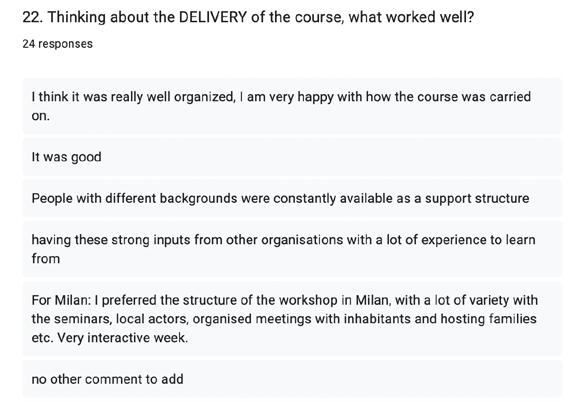
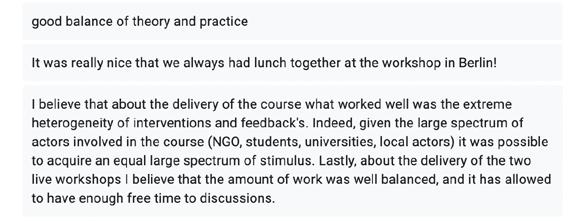





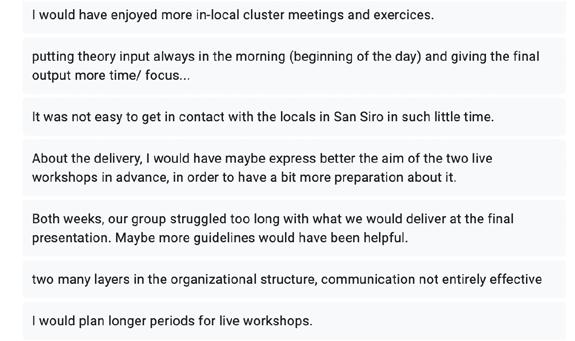
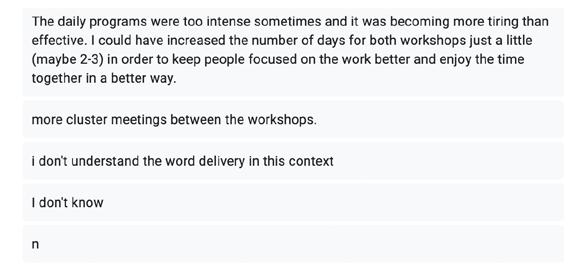




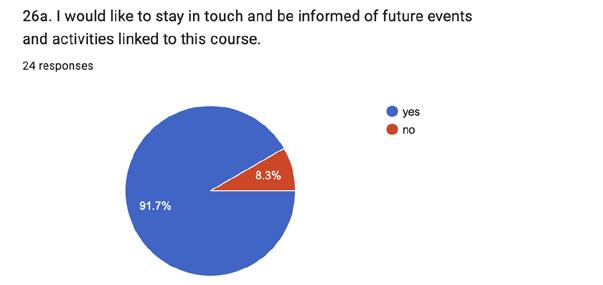

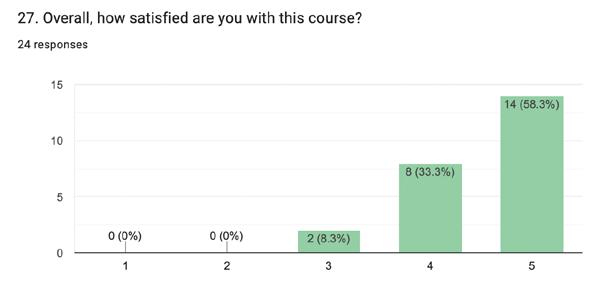
Maria Elena Ponno
Sebastián Oviedo
Agnes Fouda
Joëlle Spruytte
Santiago Peluffo Soneyra
Camille Hendlisz
Maha Komber
Sarah ten Berghe